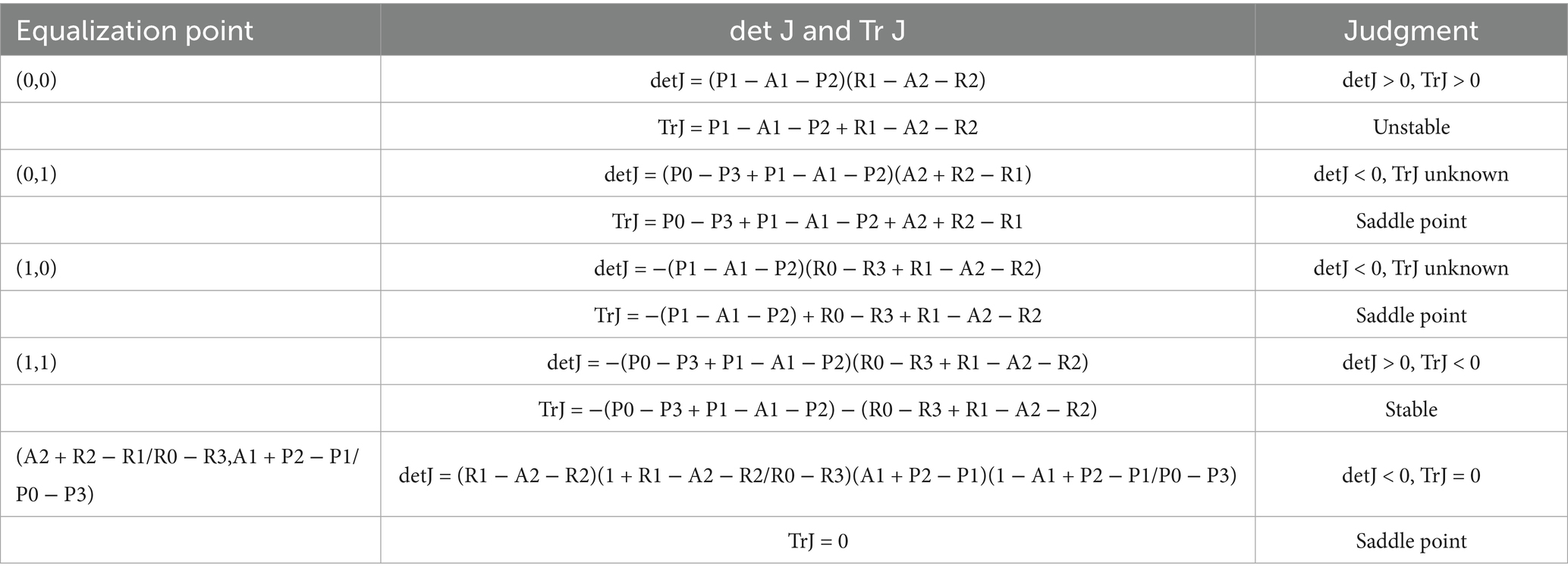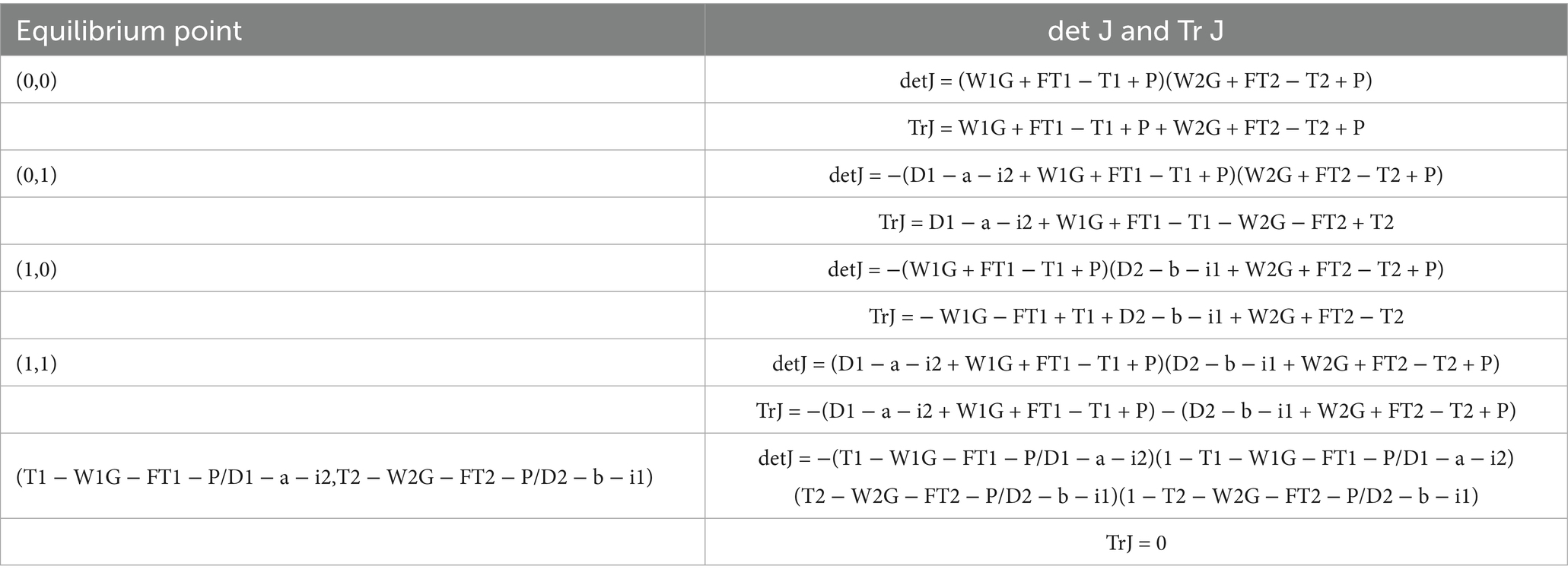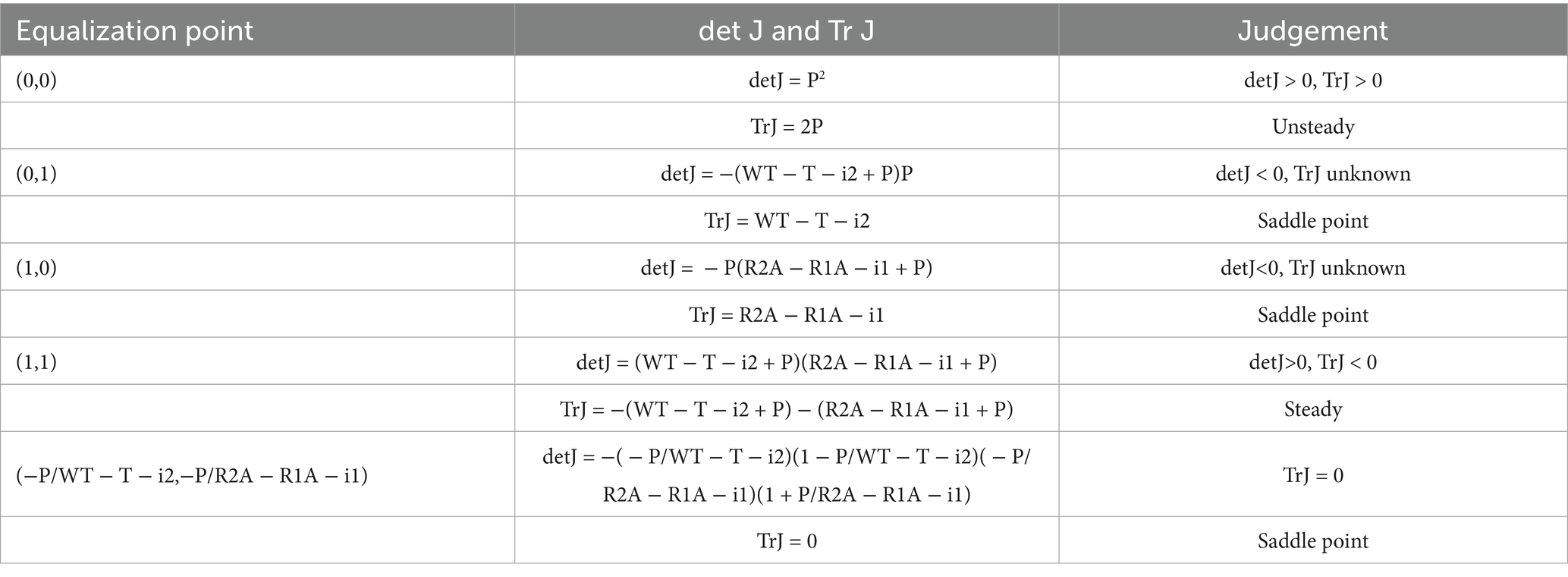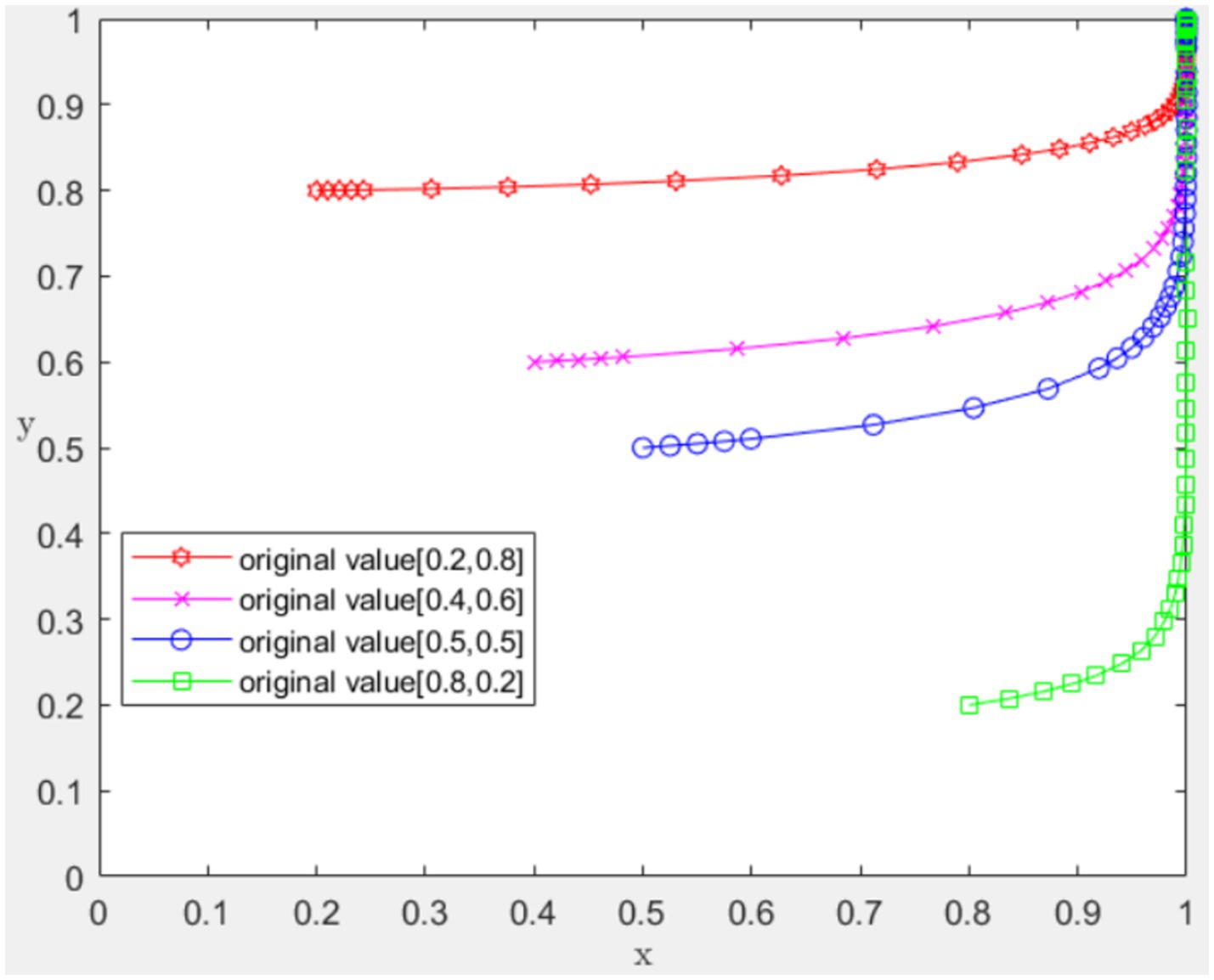- College of Economics and Management, Northwest A&F University, Xianyang, China
Achieving sustainable agricultural green development requires a dynamic and collaborative framework that integrates both innovation-driven mechanisms with policy guidance. This study employs an evolutionary game theory model to examine the interactions among farmers, government, enterprise, university research institutes, and social capital in the context of green farming practices. A multi-agent strategic decision model is developed to explore the stable conditions necessary for green agricultural cooperation and the factors influencing strategic equilibrium. The findings reveal that policy clarity and strength, market feedback on demand, intellectual property protection, and the collaborative capacity of innovation entities are all crucial for sustainable green farming practices. Moreover, the study highlights the negative impact of knowledge spillover, which can undermine cooperative efforts. Through analog simulation, the study demonstrates that targeted subsidies and regulatory mechanisms effectively promote the long-term sustainability of agriculture. These results offer policy insights for enhancing green development strategies through a balanced approach that combine internal innovation with external governance. The study contributes to the theoretical understanding of evolutionary game dynamics in green agricultural development and provides practical recommendations for policymakers, researchers, and enterprise stakeholders.
1 Introduction
1.1 Opening remarks
Agricultural green development emphasized on resource conservation, environmental sustainability, and product safety, forming the foundation for circular agriculture, ecological, and green agricultural systems. Its primary objective is to enhance economic efficiency in agriculture while simultaneously protecting the environment and optimizing resource use, in line with the principles of comprehensive, coordinated, and sustainable development. This transformation depends on advanced technologies, efficient management strategies, and modern agricultural equipment to achieve a balance between economic viability and ecological sustainability. The shift from traditional, quantity-based agricultural models to quality-driven, sustainable systems necessitates effective resource allocation and systematic ecological planning. According to Zhou (2023), green agricultural development is a continuous process that integrates innovative concepts from farming, business, and environmental management to establish a robust and modern agriculture system. Since the 18th CPC National Congress, the central government and relevant ministries and commissions have successively issued several policy documents including the “Opinions on Innovating Mechanisms and Systems to Promote Green Development in Agriculture,” the “National Agricultural Green Development Plan for the 14th Five-Year Plan Period,” and the “Plan for Accelerating the Construction of a Strong Agricultural Country (2024–2035).” However, the policy effects in some regions remain limited, which continues to hinder large-scale adoption (Li et al., 2025). Between 1978 and 2020, agricultural fertilizer application increased from 8.84 million tons to 52.5 million tons, a 4.94-fold rise contributing to environmental concerns (Huogen and Shuang, 2024). Moreover, the supply of high-quality agricultural and ecological products remains insufficient to meet growing consumer demand (Wei et al., 2022). To address these challenges and facilitate the transition toward greener and lower carbon-agriculture, it is essential to establish a coordinated development mechanism guided by a system dynamics approach. This represents not only a theoretical advancement in modernizing agricultural production but also a practical necessity for achieving the triple dividend of economic growth, technological innovation, and environmental protection. A structured and well-integrated green agricultural framework is critical to ensure the long-term sustainability and competitiveness of the sector.
At present, China’s agricultural green coordinated development faces three major practical challenges. 1. Inefficient subject collaboration: The government-led “top-down” model results in insufficient interaction among enterprises, research institutions and farmers (Zhou, 2023). For example, agricultural production activities remain overly dependent on government subsidies, and the capacity for market-oriented operations is weak (Yao et al., 2025). 2. Technology transfer gap: In 2024, the contribution rate of agricultural scientific and technological progress reached 63.2%. However, most green technologies developed by universities have not been implemented due to the lack of collaboration with enterprises (Chenjun et al., 2020). 3. Limited policy instruments: Current green agricultural policies emphasize ecological civilization but overlook associated economic benefits (Qun et al., 2023).
Although the existing literature has not comprehensively examined the operational mechanism underlying agricultural green coordinated development, this study transcends geographical limitations by constructing an “innovation-policy” coordinated driving framework applicable to international agricultural green coordinated development. The problem of dynamic game mechanism design is addressed through system dynamics simulation, and the strategic interaction logic among various stakeholders is quantitatively analyzed from a system dynamics perspective, this study investigates the internal innovation and external policy-driven mechanisms underlying agricultural green coordinated development. It also simulates the impact of different policy scenarios on equilibrium selection and strategic stability among key stakeholders. This model innovatively integrates three broadly applicable dimensions: (1) the technology spillover effect observed in the EU agricultural context (Jekaterina et al., 2023); (2) the institutional learning curve in production and management (Christoph, 2019); (3) the behavioral adaptation model of small-scale peasant system in Asia (Fuhua et al., 2025). Ultimately, it offers a unified analytical framework for understanding the dynamic interaction between endogenous innovation and exogenous policy drivers across diverse global agricultural sustainability transitions.
1.2 Literature background
1.2.1 Foreign academic review and research trends
Multi-agent collaboration is often called “collaboration” and “collaborative governance” in foreign countries. It was initially proposed by the German physicist Hermann Haken. The core of the collaborative concept is that subsystems of complex systems transition from disorder to order through the self-organizing process. In the 1980s, with the emergence of the new public management movement, scholars began to discuss collaboration among business organizations. Donahue first proposed and defined “collaborative governance” in 2004 (John, 2004), which is characterized by the following elements: attention to public affairs, direct stakeholder participation in decision-making, and the goal of reaching consensus. Mechanism for multi-agent collaboration: Early collaborative research primarily focused on fields such as public health, education, social welfare, international relations, and others. The discussion of the collaborative process among various entities includes the collaborative model (Selin and Cheez, 1995), the inter-departmental collaborative model (Bryson et al., 2006), and collaborative governance model (Ansell and Gash, 2008). In 2012, Campos reviewed existing collaborative evaluation models and proposed the multi-criteria collaborative evaluation model (MCE), which has been widely recognized (Rodriguez-Campos, 2012). Multi-agent collaboration in green development: In the context of multi-agent collaboration in environmental development, scholars, primarily draw on stakeholder theory, and use multi-criteria decision analysis (MCDA) and the Q classification method to investigate and analyze the attitudes of various agents, aiming to promote concerted actions (Talukder et al., 2017; Langemeyer et al., 2016; Belanchee et al., 2021). Multi-agent collaboration in agricultural green development: Most scholars advocate for multi-agent collaboration in agricultural green development by constructing coordination frameworks, promoting evidence-based decision-making, institutional capacity building, and improving resource allocation efficiency (Khatri-Chhetri et al., 2019; Yongabo and Goktepe-Hultén, 2021). Wijaja et al. (2018) analyzed the challenges of multi-agent collaboration in green agriculture and found that constraints such as farmers’ funds, insufficient economic profits, unclear division of power and responsibility between government and enterprise, differences in organizational culture, and gender issues hinder the green collaborative development of agriculture. Conway and Barbier (2013) examined the impact of policy coordination among international, national, and local governments on the green development of agriculture. They explored the same topic in 2013, focusing on agricultural green development and the role of coordinated policies. As the research on agricultural green collaborative development progresses, the application of game theory has gradually increased, though it remains largely limited to a single aspect of collaborative game analysis. For example, Yuhan et al. (2021) proposed a non-cooperative game framework for green supply chains, based on the effective integration of information and communication technology and agricultural green practices. By embedding blockchain technology, the agricultural green system’s transparency was significantly enhanced. Jian et al. (2023) developed a tripartite game model of government, polluting enterprises, and renewable energy enterprises based on the development of the CCER project in the carbon market. As a mathematical methodology specializing in the study of competitive phenomena, the application of game theory in agricultural green collaborative development warrants further exploration.
1.2.2 Domestic academic review and research trends
In China, collaborative development emphasizes interconnectedness and influence within the process, implementing unified coordination and planning to achieve the ideal state. The term “multi-agent collaboration” first appeared in the study on state-owned enterprise reform (Jielong, 1997), and was later applied primarily to regional economic development. With the continuous evolution of synergy theory, Jianfang (2011) introduced multi-agent synergy mechanism and institutional change pathways for the quality and safety development of agricultural products. Multi-agent collaboration mechanism for agricultural green development: Since the introduction of “agricultural green development” scholars have conducted numerous studies on multi-agent collaboration in promoting green technology in agricultural products and in the prevention and control of non-point source pollution (Zuhui, 2018). To achieve the green development of agriculture, a “five-in-one” multi-agent collaborative approach involving farmers as the primary stakeholders, government leadership, enterprise leadership, scientific and technological support, and social participation is essential (Yanli and Hua, 2021). In the green development of agriculture, multi-agent cooperation can mitigate government failure, address information asymmetry, and enhance market operation efficiency. With the continuous practice of collaborative thinking in the field of agricultural green development, it has been observed that, compared to government supervision at both the central and local levels (Yingying et al., 2023), enterprise supervision is more effective in regulating farmers’ green production behaviors and is more conducive to optimizing the market environment of green agricultural products (Huijiao et al., 2017). However, enterprises’ requirements for “standardization and scale” of agricultural products increase pressure on farmers. The passive addition of more means of production means ultimately elevates food safety risks (Yafei and Shuang, 2013). To ensures the steady realization of agricultural green development, scholars have applied game theory model to analyze the interaction among multiple stakeholers in agricultural green development (Xiuchuan and Pengyan, 2022). Policy simulation is employed to explore the optimal policies in a given context, aiming to address significant regional disparities in agricultural green development (Qiannan et al., 2022). Research on the evolutionary game of domestic green coordinated development in agriculture has led to the creation of a systematic analytical framework for multi-agent interactive relationships. The core of this framework lies in revealing the strategic choices and dynamic balance mechanisms among various subjects such as the government, enterprises, research institutions, farmers and intermediary organizations. Recent research shows that the government, as a provider of systems, guides the evolution direction of the system through a dynamic combination of subsidy intensity and pollution taxes and fees (Xufang and Yangmei, 2024). Meanwhile, the green technological innovation behavior of agricultural supply enterprises is influenced by both the intensity of consumer preferences and the level of intellectual property protection (Huafeng et al., 2023; Jun and Hao, 2024). Farmers shows behavioral characteristics such as risk aversion and the herd effect. The demonstration effect of cooperatives can reduce their perceived transformation costs, and an increase in government subsidies can enhance farmers’ willingness for green production (Xiuchuan and Yande, 2024). There exists a spatial overflow boundary in the “innovation-application” collaboration between scientific research institutions and enterprises (Jing, 2022), and social capital play the role of signal transmission in the context of information asymmetry. The higher its level of participation, the more conducive it is to the green development of agriculture (Jianhui and Kaixuan, 2024). However, most existing studies focus on the empirical analysis and qualitative discussion of the effects of agricultural green policies (Haixia et al., 2018), giving insufficient attention to the dynamic interaction during the policy implementation process. The limited simulation of agricultural green policies is two-party games (Zhe et al., 2024), as well as the three-party games (Yuehua and Ye, 2022; Xiaoxiao et al., 2023). Literature on the in-depth integration of policy simulation and modeling in the research on the green and coordinated development of agriculture remains relatively scarce. There is an urgent need to build a more realistic scenario-based policy simulation model that aligns with the coordination of multiple stakeholders.
1.2.3 Research review at home and abroad
First, the research subjects of the multi-agent coordination mechanism in the field of agricultural green development are incomplete. International studies mostly consist of qualitative analysis of specific cases. Domestic research often overlooks the systematic role of research institutions and intermediary capital, resulting in insufficient exploration of the bridging role of research institutions in technology transformation and the function of intermediary capital in reducing information asymmetry. Secondly, methodological limitations are evident, particularly the serious disconnection between static analysis and dynamic processes. One issue is the inability to identify the system’s evolution process, while another neglect of the nonlinear characteristics of the feedback mechanism. Third, the path dependence of strategy interactions is often oversimplified. Finally, defects in the theoretical framework lead to the artificial separation of collaborative innovation and collaborative participation. Many studies focus primarily on local equilibrium.
This study constructs a dynamic model of the six-subject system analysis framework, which includes the government, farmers, enterprises, research institutions, universities and capital, while incorporating research institutions and intermediary capital. By integrating innovative research methods such as evolutionary game theory and simulation, the study depicts the evolution process and nonlinear characteristics of multi-agent strategies, addressing the previous limitations.
2 Materials and methods
2.1 Innovative and environment-driven agricultural green collaborative development mechanism
The General Office of the State Council released the Opinions on Promoting the Green Development of Agriculture through Innovative Systems and Mechanisms in 2017. These clearly stated that innovation is the key to promoting the green development of agriculture and that creating an environment for it is the only way to be sure of success.
In essence, the government, enterprise, university, research institutes, social capital, and farmers are used to coordinate with each other and jointly achieve the goal of the green development of agriculture. Academic research is one of the main sources of internal innovation that drives agricultural green collaborative development. This includes the pursuit of scientific and technological innovation by university research institutes and enterprise. The pursuit of turning scientific and technological innovation achievements into real products, also known as the pursuit of product innovation, requires a lot of money to make sure that scientific innovation and achievement transformation and other agricultural green development goals are met. In this paper, it is classified as the internal innovation driving part. The government controls the outside world that affects the coordinated growth of agricultural green. This means that the government makes agricultural green development policies that help everyone start on the path of agricultural green transformation, and farmers are the ones who make these policies, scientific advances, and funds possible. This paper takes the enterprise-university-research-social capital as the internal driving wheel, the government as the external environment guidance wheel, and the funds as the lubricant of the internal and external operation. The joint action of internal promotion and external pull, achieves the goal of sustainable and stable agricultural green coordinated development as shown in Figure 1.
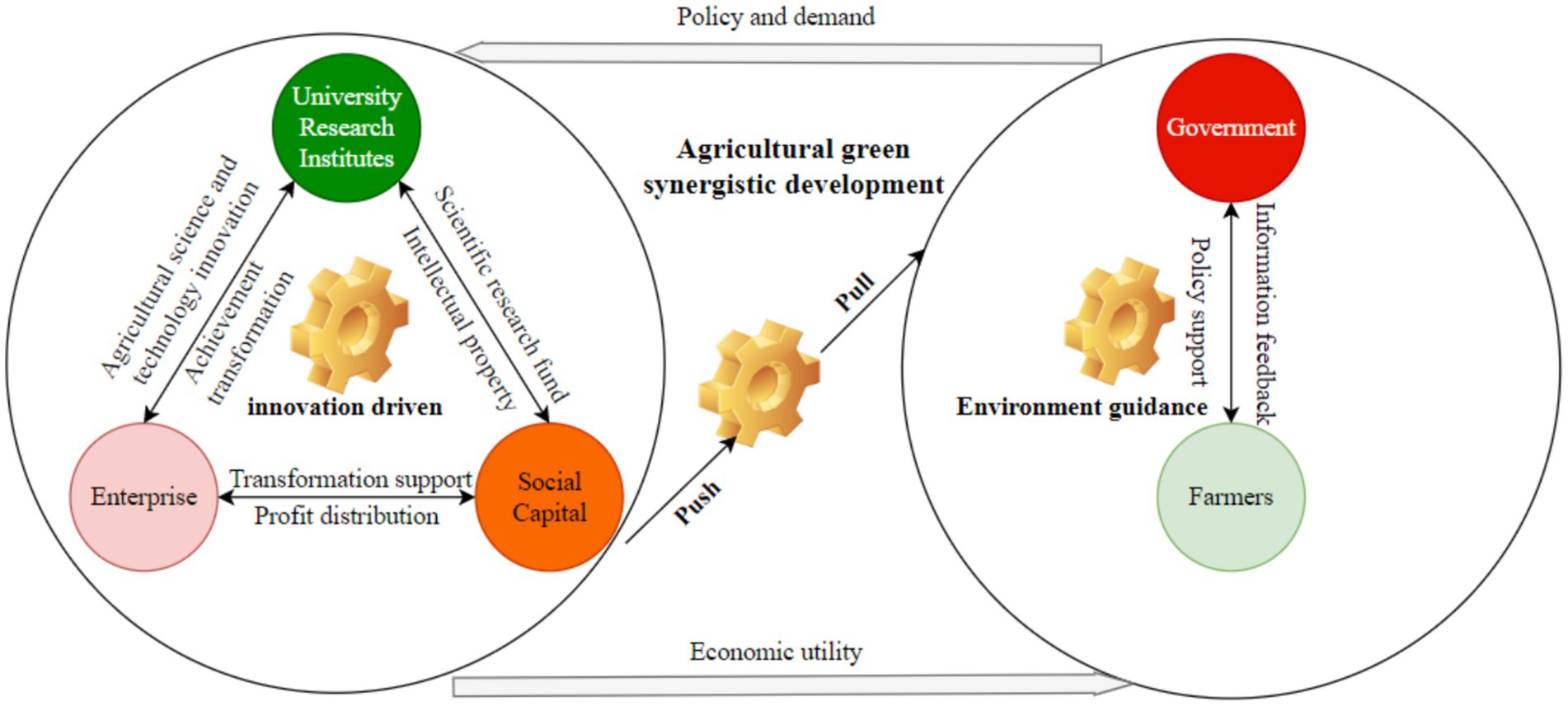
Figure 1. The mechanism of innovation-driven and environment-guided agricultural green collaborative development.
The university research institutes within the collaborative innovation system for green agricultural technology serves as the primary source of new knowledge. It drives technological progress through research and development (R&D). The enterprise, on the other hand, commercializes technological advancements and bridges them with market demand. Meanwhile, the social capital provides financial support to address funding challenges in scientific research, technology development, and commercialization. Motivated by economic incentives, these three sectors collectively drive the collaborative innovation system. Based on the principles of shared risk and benefits, the system promotes the free exchange of knowledge and information. This fosters stable and sustainable growth in collaborative innovation while enhancing the system’s efficiency and adaptability.
In an environmentally driven governance framework, the government plays a leading role in organizing, coordinating, and implementing policies to promote green agricultural development. By formulating and enforcing new policies, the government provides a supportive policy environment that facilitates multi-stakeholder coordination. Farmers, as key market participants, provide feedback that helps align collaborative efforts with market demand while reducing the costs associated with identifying optimal strategies. An interactive communication mechanism exists between farmers and the government, allowing policymakers to adjust regulations based on farmers’ input. This continuous exchange fosters a dynamic policy environment, creating a strong external driving force that propels the coordinated development of sustainable agriculture. In the study of the evolution of green agricultural coordination, government regulation plays a crucial role in shaping farmers’ production decisions. Analyzing the strategic interactions between the government and farmers lays the foundation for understanding how policies influence farmer behavior. Next, the coordination between enterprise and university research institutes help bridge the gap between technological development and practical application, facilitating the implementation of green technology. Finally, partnerships among enterprise, university research institutes and social capital ensure financial stability, equitable income distribution, and the sustainable operation of the coordinated system. This sequence follows the primary functions and key roles at each stage of development. Despite the complexity of real-world interactions, this approach provides a logical framework for analysis.
2.2 Agricultural green coordinated development environment guide evolutionary game
Rousseau’s Theory of Social Contract says that an ideal government can only exist if all citizens give up their natural freedom in exchange for contract freedom. In this case, strict assumptions must be met for the government to be able to perfectly step in and regulate the market. It is generally believed that the modern economic system is an effective combination of government intervention and market regulation. Approaching the best combination of the two is the key to ensuring economic development. So, the key to making a good external environment for the multi-agent game for the coordinated development of agricultural green is for the government and the market to work together to make sure that the national strategy is very in line with what the market wants. This paper builds a game evolution model using Weihong et al.’s (2018) research on collaborative innovation as a starting point. The model constantly changes its own decisions based on the other side’s strategies, assuming that both sides are limited in their ability to reason. Finally, stabilizes the system Qian (2023).
2.2.1 Hypothesis and model construction
In the evolutionary game theory of green and coordinated agricultural development, the strategic interaction between the government and farmers under bounded rationality constitutes the starting point of system evolution: The government, based on ecological cognition and the trade-off between policy cost-effectiveness, establishes a dual intervention path that involves lowering economic thresholds and reshaping long-term expectations through fiscal and tax subsidies (Shuangqing et al., 2021). The group of farmers shows behavioral heterogeneity due to differences in risk tolerance (Mingzhong and Xiankai, 2022). The demonstration effect of early adopters triggers the diffusion of group strategies through social learning mechanisms. This reveals the accelerated accumulation characteristics of policy spillover benefits: when the support intensity covers the initial cost of transformation and the participation rate exceeds a critical threshold, the positive feedback mechanism drives the system to escape the low-level equilibrium trap and achieve the phase transition from a non-cooperative game to coevolution. Ultimately, the dynamic coupling of policy tools and market mechanisms guides the system to converge toward the Pareto-optimal stable state. This process illustrates the dialectical unity of the theoretical framework, where institutional innovation guides behavioral adaptation, and behavioral feedback optimizes policy design.
Hypothesis 1: Within the strategic framework of coordinated green agricultural development, the cooperative game involves the government and farmers, including large-scale farmers and new agricultural operators. Due to the information asymmetry between both parties, this game does not follow perfect rationality but is more aligned with a cooperative game under bounded rationality, as described by Arrow (Lingdi et al., 2020).
Hypothesis 2: Local governments decide whether to regulate farmers’ pollution based on their understanding of agricultural non-point source pollution. While regulation can help reduce emissions, it also incurs costs. Failure to implement such regulations may lead to unchecked farming expansion and ecological degradation (Zhe et al., 2024).
The government has two options for fostering a favorable environment for green agricultural growth: providing support or withholding support. Support refers to the government actively implementing preferential policies, such as tax incentives and subsidies, to encourage farmers to adopt environmentally friendly production practices. Withholding support means the government neither promotes nor obstructs green agricultural production, allowing farmers to operate without intervention.
To figure out the government’s profit and loss, let us assume it decides to offer different kinds of fiscal and tax preferential policy support. This decision will incur a cost it A1, provide a benefit of P1, and create an additional policy spillover benefit, R3, when there is only government support. If the government chooses not to support the strategy, it will receive P2 in tax revenue.
Hypothesis 3: Farmers can choose between green production, which aligns with environmental protection goals, and conventional production, which may prioritize short-term gains over sustainability (Lingdi et al., 2020). In a favorable external environment for green agriculture, farmers face a strategic decision between adopting green practices (“use”) or maintaining conventional methods (“no use”).
Transitioning to green production incurs material and labor costs, denoted as A2. Farmers earn R1 from green production. However, an additional payoff of P3 arises if only a few farmers transition, while others continue with conventional production. If a farmer chooses not to adopt green production, their return is R2.
Hypothesis 4: If the government chooses to provide support and farmers choose to adopt green strategies, the spillover effect resulting from mutual cooperation exceeds the benefits of unilateral action. As a result, the government and farmers each receive spillover benefits, denoted as P0 and R0, respectively (see Table 1).
2.3 Agricultural green coordinated development innovation-driven evolutionary game
Right now, green agricultural development has not turned into a market-driven system, and the way the government builds the environment is also influenced by what the market wants. Based on the logic of government behavior, first, enterprise, university research institutes and social capital have the conditions for innovation. If we assume that both the government and farmers are actively involved in green agricultural production, then it makes more sense to study how innovation-driven links work. As the primary driver of scientific innovation and achievement transformation, there exists a dynamic relationship between university research institutes and enterprise, while social capital, serving as a facilitator of knowledge exchange, support for scientific research, funding for transformation, and distribution of profits, also plays a role. Therefore, we divide the innovation-driven link into two games. Because of the urgent need for capital during this economic downturn, the mechanism for overseeing scientific and technological innovation funds in the capital link is being constantly improved, and new internal oversight factors for capital are being added.
2.3.1 Game between enterprise and university research institutes
2.3.1.1 Hypothesis and model building
In the innovative game theory of green and coordinated development in agriculture, the government guides enterprises and university research institutes institutions to form innovation alliances through precise fiscal and tax policy tools. The efficiency of subsidy distribution directly affects the participation enthusiasm of both parties (Zhiyuan and Weihong, 2022). The feedback from farmers’ demands at the market end serves as the central mechanism for realizing innovative value, promoting the formation of a closed loop between technology supply and industrial application. There is strategic complementarity between the innovation behavior of enterprises driven by market signals and the R&D activities guided by policies of university research institutes. The coordinated innovation of the two not only generates knowledge spillover effects but also faces the risk of “free-riding” due to insufficient protection of intellectual property rights (Xiao et al., 2025). It reveals a triple dynamic balance mechanism: the matching mechanism: the matching mechanism between the precision of policies and the responsiveness of innovation entities determines the efficiency of subsidies; the coordination mechanism between the transmission of market demand and the sharing of innovation costs affects the stability of cooperation; and the balancing mechanism between the intensity of intellectual property protection and the severity of imitation penalties ensures the sustainability of innovation.
Hypothesis 1: Tax cuts, financial aid, lower rent, and other special policies, all of which are written as G (Qilong et al., 2023), are ways that the government encourages green agricultural development. Various stakeholders involved in green agricultural development, including enterprise and university research institutes, receive different levels of subsidies based on their respective contributions. In this study, it is assumed that the industrial sector responsible for technology commercialization receives a subsidy G, while the research sector engaged in knowledge production also benefits from G. The distribution of these subsidies is determined by policy accuracy, represented by W1 and W2, where 0 < W1, W2 < 1.
Hypothesis 2: Scientific and technological innovation, along with the transformation of research outcomes, is driven by market demand for green agricultural development, with the goal of enhancing agricultural sustainability through technological advancements. As key market participants, farmers’ feedback plays a crucial role in connecting scientific and technological innovations with market needs. Therefore, a strategic interaction exists among enterprise, research institutes, and farmers (Xiaozhou et al., 2016; Xingbin et al., 2014). This study assumes that farmers’ behavior and feedback influence green agricultural scientific innovation and technology transfer, with this effect represented by F.
Hypothesis 3: As producers of science and innovation in agricultural green development, their choice of attitude towards science and innovation is influenced by their own functional attributes. Enterprises are at the forefront of the market economy, and they receive market demand information on agricultural green development with accuracy and timeliness. University research institutes are more oriented to information about the government policy channels for science and innovation (Genming and Manning, 2020). Therefore, there are multiple possibilities for the two strategies. When both parties adopt a positive attitude {positive, positive}, the innovation costs of each other are a and b, respectively; when only one party actively participates or both are negative, the innovation costs of each other are D1 and D2, respectively; and the benefits of one party from the spillover of the other party’s innovation activities are i1 and i2. On both sides, profit simplification is assumed to be T1 and T2 and does not vary with strategy changes (in general, the research output value return period is long).
Hypothesis 4: The benefits of scientific and technological innovation depend on the protection of intellectual property rights. China established its intellectual property protection system later than developed countries, and its legal framework still needs improvement. Technological innovation often follows a cyclical pattern: the emergence of new technology, imitation by other enterprises, market saturation, and the subsequent development of newer technologies. The distinction between legal imitation and outright intellectual property theft often blurs, driven by financial incentives. Therefore, we must establish a regulatory framework to safeguard intellectual property rights in green agricultural technology innovation. The level of punishment used in this study is shown as P (Zhe and Bin, 2023), and it is assumed that one party actively innovates while another copies (see Table 2).
The probability of active participation by producers in the commercialization of green agricultural scientific and technological achievements is denoted by X. Similarly, the probability of active participation by university research institutes in green agricultural scientific and technological innovation is denoted by Y. The dynamic differential equation describing their interaction is given as follows (Equations 1 and 2).
2.3.2 A game between enterprise-university research institutes and social capital
Finance is the lifeblood of economic development, and whether it comes from government funding or social capital, it plays a crucial role in driving scientific and technological innovation for sustainable green agricultural development (Hemmert et al., 2014). To examine the impact of social capital on technological advancements in green agriculture, a dynamic game model involving enterprise-university research institutions should be developed. This model will help analyze how social capital influence the stability of coordinated scientific and technological innovation in the green agricultural sector.
2.3.2.1 Hypothesis and model building
Under the innovative game framework of green and coordinated development in agriculture, the strategic choices of enterprise-university research institutes alliances and social capital present dynamic evolution characteristics. When both sides adopt a passive response strategy, innovation activities become fragmented, with knowledge production and capital investment operating in isolation, resulting in a loss of innovation efficiency and the repetitive allocation of resources (Zhiying et al., 2024). The active cooperation strategy, through the establishment of a contractual relationship that includes information sharing and risk sharing, creates a systematic integration of innovative elements. Although this institutional arrangement requires higher coordination costs, it can generate a significant knowledge aggregation effect. Due to the inherent information asymmetry in technological innovation, unilateral innovation investment is susceptible to knowledge spillover and free-riding behavior (Yijie et al., 2024). This makes the contract enforcement mechanism and intellectual property protection the key variables for the stability of cooperation. A sound institutional design can not only curb speculative defaults but also internalize positive externalities, ultimately shifting the game from a non-cooperative equilibrium to a coordinated innovation equilibrium. It reveals the dialectical relationship of the compatibility of institutional constraints and incentives in green technological innovation, providing a core principle for the design of the coordination mechanism among enterprise-university research institute alliances and social capital.
Hypothesis 1: Building on Weihong et al.’s. (2018) ideas, enterprise, university research institutes, and investors can choose between two strategic approaches: a positive or a negative response to scientific and technological innovation in green agricultural collaborative development. When both parties respond negatively, they engage in scientific and technological innovation independently, without collaboration. In this case, the net profit from collaborative innovation among enterprise, university research institutes, and investors is denoted as T, while the return on capital investment is R1. When both parties actively engage in collaboration and establish a contract for information sharing, benefit sharing, and risk distribution, the investment cost is A, the investment return rate is R2, and the net income from innovation among enterprise, university research institutes is WT.
Hypothesis 2: There is an information asymmetry in access to scientific and technological innovation information, and only one party experiences a positive externality when innovating independently. To safeguard the rights and interests of knowledge producers, it is essential to improve cooperation agreements, particularly in terms of contract enforcement mechanisms and intellectual property protection. The breach of contract by the other party and the gains from knowledge spillover are denoted as i1 and i2, respectively (see Table 3).
The probability of enterprise university research institutes s actively participating in the collaborative innovation and commercialization of green agricultural scientific and technological achievements is denoted by X. Similarly, the probability of social capital actively participating in coordinated innovation within green agricultural scientific and technological development is denoted by Y. Their interaction can be described by the following dynamic differential (Equations 3 and 4):
3 Results
3.1 The game between government and farmers
3.1.1 Evolutionary equilibrium point analysis
P1 − A1 + P0 and R1 − A2 + R0 indicate that the government and farmers can foster a favorable environment only when the benefits of actively supporting green agricultural development outweigh those of inaction or negative treatment. The relative values of P0, P3, R0, and R3 depend on whether policy support aligns with farmers’ demand for green agricultural development. If P0 > P3 and R0 > R3 hold, policy support aligns with public demand, ensuring that both the government and farmers actively contribute to establishing an environment conducive to coordinated green agricultural development.
The interaction between the government and farmers follows a mixed-strategy game rather than a pure strategy game.
Suppose the government chooses {support} with probability X and {not support} with probability 1 − X. Similarly, farmers choose {adopt} with probability Y and {not adopt} with Probability 1 − Y.
The expected return of the government’s support strategy is:
The expected returns of the government’s non-supported strategy is:
The government’s average expected return is given by: XM11 + (1 − X)M12.
The dynamic differential equation for the government’s support strategy is as follows (Equation 5):
3.1.1.1 Replicator—dynamic equilibrium analysis
When X takes values within the interval [0,1] and remains at 0, an equilibrium steady-state is reached. When the system reaches a steady state at both 0 and 1, the stability of these equilibrium points is evaluated.
Through stability analysis, it is found that F′(X) > 0 at X = 0, indicating that selection pressure favors the adoption of government support. Conversely, F′(X) < 0 at X = 1, implying that selection pressure does not favor this strategy. Therefore, X = 1 represents an equilibrium steady-state, meaning the government choosing to support green agricultural development is an evolutionary equilibrium strategy.
Similarly, when F′(X) < 0 at X = 0 and F′(X) > 0 at X = 1, X = 0 represents the equilibrium steady-state, meaning the government opts not to support green agricultural development as its evolutionary equilibrium strategy.
3.1.2 Farmer support strategy—expected payoffs
The expected payoff for farmers who adopt this strategy is: N11 = X(R1-A2 + R0) + (1 − X)(R1-A2).
The expected return for farmers who do not adopt the strategy is: N12 = X(R2 + R3) + (1 − X)R2.
The average expected income for farmers is: N=YN11 + (1 − Y)N12.
The dynamic differential equation for the farmer support strategy is as (Equation 6):
3.1.2.1 Replication dynamic equilibrium analysis
When Y takes values in [0,1], the equilibrium steady-state is reached at 0 or 1. Stability is evaluated using the partial derivative of F(Y).
• If F′(Y) > 0 at Y = 0, selection pressure favors adoption.
• If F′(Y) < 0 at Y = 1, selection pressure does not favor adoption.
Therefore, Y = 1 represents an equilibrium steady-state, meaning farmers adopt green agricultural development as their evolutionary equilibrium strategy. Conversely, if F′(Y) < 0 at Y = 0 and F′(Y) > 0 at Y = 1, Y = 0 is the equilibrium steady-state, meaning farmers choose not to adopt green agricultural development as their evolutionary equilibrium strategy. Figure 2 shows the phase diagram of the dynamic differential equation.
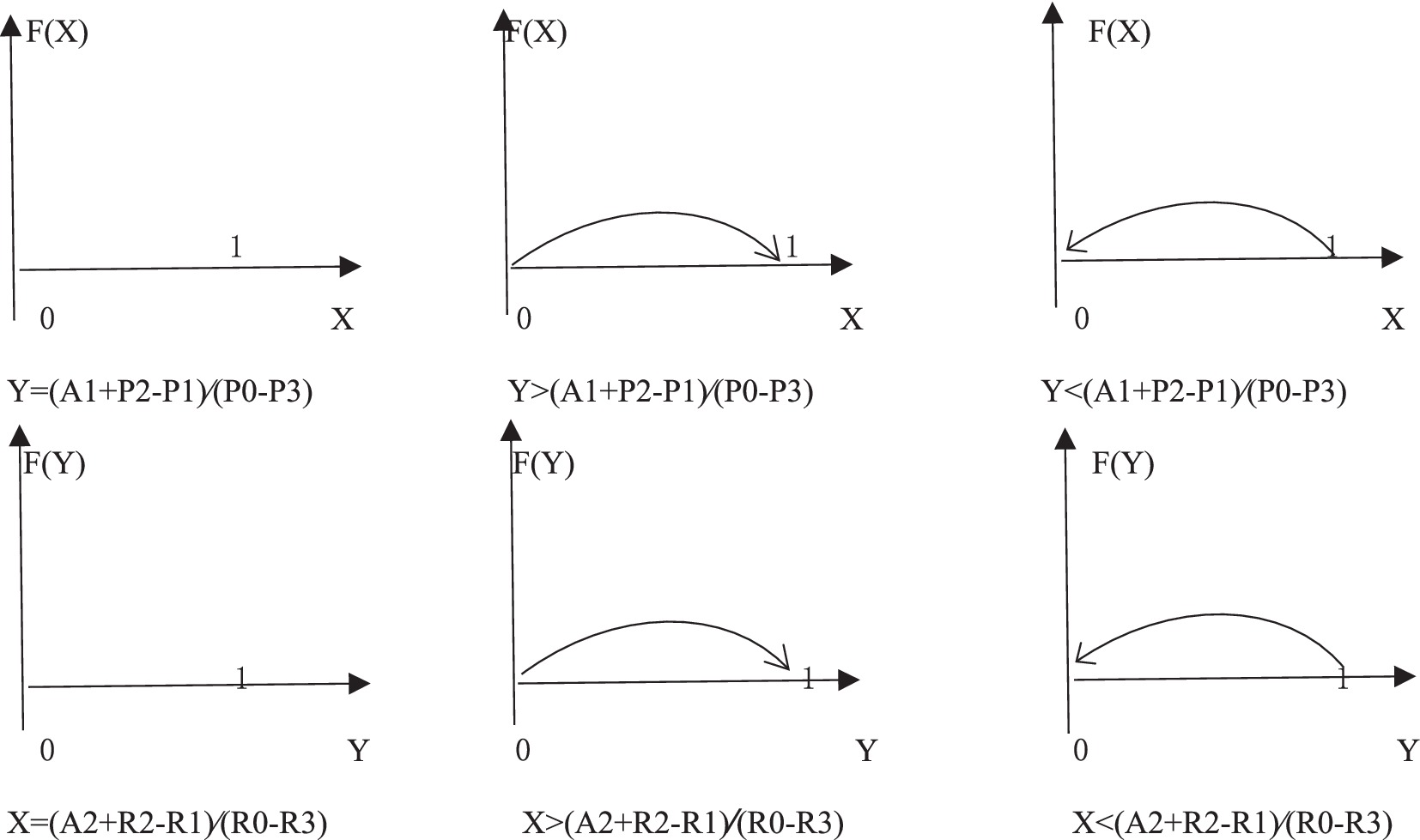 " or "<") under each graph." id="fig2" loading="lazy">
" or "<") under each graph." id="fig2" loading="lazy">
Figure 2. Phase diagram and stability analysis of the dynamic differential equation.
3.1.3 Stability analysis of evolutionary equilibrium points
In dynamic systems theory, a system is locally asymptotically stable at an equilibrium point if all eigenvalues of the Jacobian matrix have negative real parts. This implies that small deviations from the equilibrium strategy will cause the system to return to equilibrium. Since the trace of the Jacobian matrix TrJ is the sum of its eigenvalues, local stability requires TrJ < 0. If at least one eigenvalue has a positive real part, the system is unstable. Additionally, for a real symmetric matrix, if the determinant detJ is positive and TrJ < 0, the system is stable.
The local equilibrium points in the dynamic game of cooperation between the government and farmers are: (0, 0), (0, 1), (1, 0), (1, 1) and (, ).
To analyze the local stability of these equilibrium points, the Jacobian matrix J is conducted as follows:
The determinant and trace of the Jacobian matrix are given by:
Based on the stability analysis of local equilibrium points, the dynamic game equilibrium remains stable when the government actively formulates green agricultural policies and farmers adopt environmentally friendly agricultural practices (see Table 4).
However, if both parties lack sufficient motivation to engage in green agricultural development—that is, when P1 − A1 − P2 < 0 and R1 − A2 − R2 < 0, the equilibrium remains stable, as indicated by det J > 0and Tr J < 0. This suggests that in the absence of adequate incentives, both the government and farmers will remain passive, leading to a stable state of inaction where no significant efforts are made toward sustainability.
Conversely, when P1 − A1 − P2 > 0 and R1 − A2 − R2 > 0, the initial equilibrium at (0,0) loses stability, causing the evolutionary game to shift naturally toward proactive engagement in green agricultural development. In this case, both the government and farmers recognize the benefits of participation, leading to widespread adoption of green agricultural strategies. Over time, this shift drives the system toward a new stable equilibrium, where sustainable farming practices and government support become the norm.
3.1.3.1 Conclusion
The active participation of both the government and farmers in green agricultural development is primarily driven by economic incentives. A balanced distribution of benefits, ensuring both efficiency and fairness, is essential for fostering a stable environment that supports coordinated sustainability efforts.
Beyond the influence of government and farmers, the stability of the (1,1) equilibrium point depends on the relative magnitudes of P0 − P3 and R0 − R3. If negative effects outweigh the incentives provided by governmental and agricultural power sources, both parties may find it more beneficial to avoid engaging in green agricultural development. In such cases, establishing a stable framework for sustainability becomes challenging, as the (1,1) equilibrium shifts into an unstable or saddle point. Therefore, ensuring that P0 > P3 and R0 > R3 is crucial to maintaining a stable equilibrium that supports long-term sustainability.
Furthermore, environmental guidance for green agricultural development must be market-driven, ensuring strong alignment between government policies and market demand. When effectively implemented, this synergy enhances policy impact, leading to outcomes greater than the sum of individual efforts and reinforcing long-term sustainability in agriculture.
3.2 The game between enterprise and university research institutes
The alliance between university research institutes enables more effective resource exchange and coordination with enterprises, enhancing overall research efficiency and innovative capacity. University research institutes specialize in basic research and cutting-edge technologies, while enterprises possess a deeper understanding of market demands and practical applications. Furthermore, this alliance strengthens the collective bargaining power of university research institutes, allowing them to negotiate better cooperation terms and secure more favorable resource allocations.
In summary, treating the coordination between university research institutions, and enterprises as a strategic alliance is an effective approach to fostering scientific and technological innovation, driving industrial upgrades, optimizing resource allocation, mitigating risks, facilitating knowledge creation, and enhancing market adaptability.
3.2.1 Stability analysis and conclusion of evolutionary equilibrium points
The local equilibrium points (0,0), (0,1), (1,0), (1,1) and (, ) are identified in the dynamic game of enterprise-university-research cooperation.
To assess the local stability of these equilibrium points, the Jacobian matrix is constructed as follows:
The determinant of the Jacobian matrix is given by:
-
The trace of the Jacobian matrix is given by:
Tr J= +]
The third phase of the dynamic game is based on the local equilibrium points of the Jacobian matrix. This phase is similar to the second phase and is summary of the phase diagram from the separate analysis above. The stability of the equilibrium points is judge by repeating the analysis of the dynamic evolutionary equilibrium points. Figure 3 shows that SADCB converges to B (1,1); that is, when the initial strategy selection probability of enterprise and research falls into the SADCB region, the game parties will form a {positive, positive} evolutionarily stable equilibrium; similarly, when the initial strategy selection probability falls into the SAOCD region, the game parties will form a {negative, negative} evolutionarily stable equilibrium. The X and Y subjects have five strategy choices, corresponding to A, B, C, D, and O, respectively. However, using dynamic differential equations, we find that O and B are Nash equilibrium points. Those who fall into the SADCB region will ultimately choose (1,1), while those who falling into the SAOCD region will ultimately choose (0,0). The size of SADCB and SAOCD represents the probability of success and failure of enterprise-university research coordination in agricultural green development. Figure 3 shows the phase diagram of the dynamic differential equation of production and research (see Table 5).
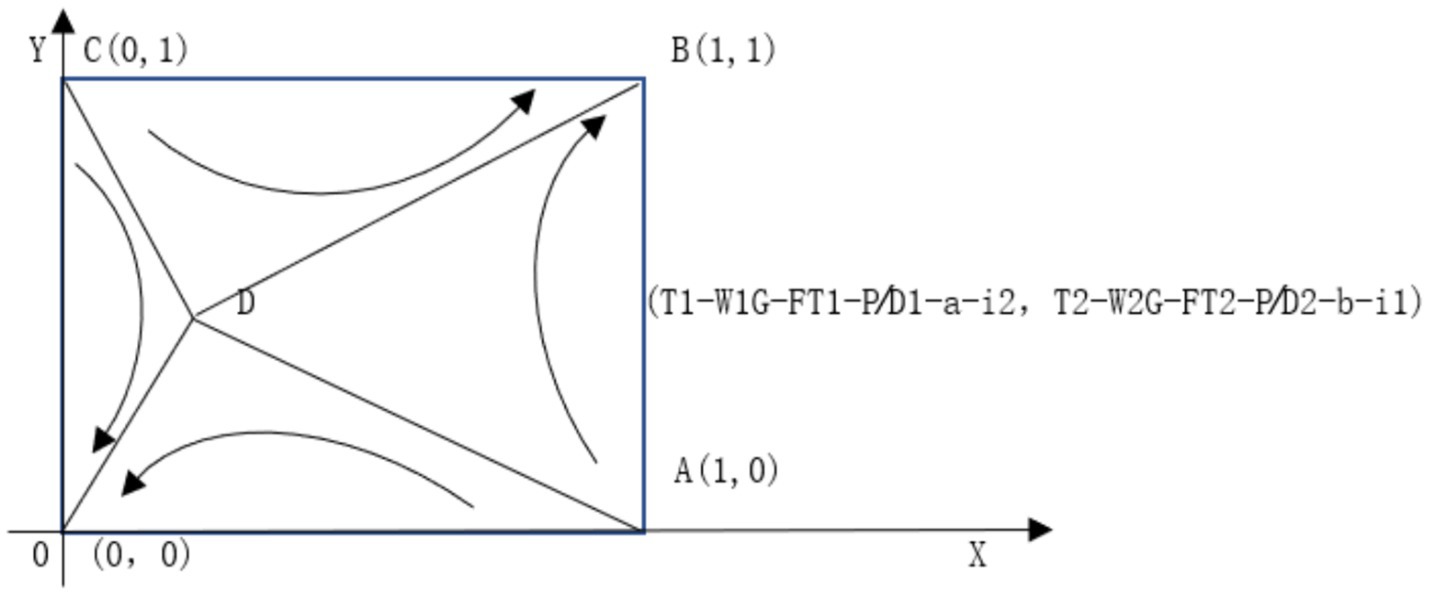
Figure 3. Phase diagram of dynamic differential equation for enterprise and university research institutes.
Under the premise of the positive response of the government and farmers, this paper analyzes the impact of policy intensity, policy accuracy, farmer feedback, intellectual property protection intensity, science and innovation spillover effect, and synergy effect on the game of agricultural green coordinated development in the link between enterprise, university research institutes through the analysis of failure probability.
Equation 7 reveals a negative first derivative of SAOCD on G, suggesting the bolstering agricultural green development policies can lower the likelihood of coordinated game failures, thereby fostering the emergence of coordinated game outcomes. Therefore, government departments should realize the purpose of government behavior toward agricultural green development and gradually strengthen policy support on the basis of ensuring that the government and farmers actively build a guiding environment. Similarly, the first derivative of SAOCD with respect to W1 and W2 is negative, and the accuracy of agricultural green development policies contributes to the success of enterprise-university research institutes coordination. The government’s participation in building a guiding environment for agricultural green development is conducive to agricultural green science and technology innovation, but government departments should fully investigate when formulating policies to ensure the targeted nature of science and innovation support policies.
It can be seen from Equation 7 that the first derivative of SAOCD with respect to F is negative, indicating that farmers’ choice of agricultural green behavior and market feedback strengthen and reduce the failure probability of cooperative game, that is, promote the emergence of coordinated game results, and farmers’ participation in building a guiding environment for agricultural green development is conducive to agricultural green technology innovation. Therefore, ensuring that the government and farmers actively build a guiding environment, unblocking the channels of innovation driving and guiding the environment, and breaking the barriers of information asymmetry between innovation and market entities will promote the emergence of the game results of enterprise-university research institutes coordination.
It can be seen from Equation 7 that the first derivative of SAOCD on P is negative, indicating that strengthening the protection of intellectual property rights in agricultural green science and innovation reduces the failure probability of coordinated games, which promotes the emergence of coordinated game results. Therefore, on the basis of ensuring that the government and farmers actively build a guiding environment, the design of the property rights system to internalize the externality of intellectual products, increase the intensity of regulatory punishment to increase the cost of intellectual property theft, and then protect the legitimate rights and interests of knowledge producers will promote the emergence of the game outcome of enterprise-university research institutes coordination.
It can be seen from Equation 7 that the first derivative of SAOCD on i1 and i2 is positive, indicating that the greater the spillover effect of agricultural green science and technology innovation, the greater the failure probability of the coordinated game, that is, the greater the failure probability of the cooperative game, the greater the inhibition of the coordinated game result. Therefore, on the basis of ensuring that the government and farmers actively build a guiding environment, on the one hand, the legitimate rights and interests of knowledge producers are protected through the design of reasonable paid intellectual property rights through the property rights system. On the one hand, we aim to streamline the quality information channel of agricultural green science and innovation products, address the issue of asymmetric information, and enhance the outcomes of enterprise-university research institutes coordination by minimizing the spillover effect of science and innovation.
Using the innovation cost difference between active participation from both parties and non-participation from one or both parties as the coordination effect index, Equation 7 reveals a negative first derivative of SAOCD on D1-a and D2-b. This suggests that a greater coordination effect of agricultural green science and innovation leads to a lower failure probability in the coordinated game, thereby promoting more coordinated game results. By making sure that the government and farmers work together to create a supportive environment, the lines of communication between agricultural green science and technology innovation and academic research are opened up. These speeds up the transformation of scientific and technological advances and improves the outcomes of partnerships between enterprise, and university research institutes by increasing the coordinated effect.
3.2.1.1 Conclusion
Effective enterprise and university research institutes coordination in agricultural green innovation hinges on targeted policy interventions, behavioral incentives, and institutional safeguards. First, enhancing the intensity and precision of policy support accelerates the adoption of green production technologies by stimulating demand for related products and services, thereby fostering supply-side innovation and synergies. Second, farmers’ green production practices serve as critical market signals, reflecting the efficacy and adaptability of technologies. Real-world implementation generates demand-driven feedback loops that guide R&D priorities, ensuring innovations align with practical needs while incentivizing collaborative engagement through profit-sharing mechanisms. Third, robust intellectual property (IP) protection is indispensable to sustaining collaboration. Clear IP frameworks mitigate free-riding risks, safeguard innovators’ returns, and reduce transaction costs associated with knowledge spillovers, thereby resolving inefficiencies in rights allocation and fostering trust among stakeholders. However, fourth, the spillover effects of green technologies characterized by involuntary dissemination of innovations pose challenges. While beneficial for societal welfare, uncontrolled spillovers diminish private returns on R&D investments, disincentivizing participation and necessitating additional safeguards (e.g., patents, confidentiality protocols) that raise collaboration costs and complexity. Finally, amplifying coordinated effects through resource integration across academia, enterprise, and university research institutes enhances innovation efficiency. Collaborative models leverage complementary strengths theoretical expertise from universities and market-driven insights from enter prisesto de-risk R&D, accelerate technology commercialization, and address systemic uncertainties inherent in green transitions.
Collectively, these findings underscore the need for a balanced policy ecosystem that harmonizes demand stimulation, IP governance, spillover management, and cross-sectoral coordination to optimize IUR outcomes in sustainable agriculture.
3.3 The game between enterprise-university research institutes and social capital
3.3.1 Stability analysis of evolutionary equilibrium points
Local equilibrium points (0,0), (0,1), (1,0), (1,1) and (, ) in dynamic game cooperation between enterprise-university research institutes and social capital are constructed to determine local stability of Jacobian matrix:
It is generally believed that when both parties participate cooperatively, the return-on-investment R2 exceeds the return-on-investment R1 when they participate alone. If R1 > R2, the return on investment from participating in coordinated innovation is low. According to the equilibrium stability analysis, it is found that detJ is positive and TrJ is negative at equilibrium point (1,0), and at which point (1,0) reaches stability, a stable equilibrium in which enterprise-university research institutes are positive and social capital is negative is formed. As R2 raises and surpass R1, the equilibrium stability point progress towards (1,1) and ultimately achieves stability, thereby enhancing the investment return rate on the capital side and advancing the coordination between enterprise-university research institutes and social capital (see Table 6).
There is a big knowledge gap between the two sides of the game when knowledge spillover brings a lot of benefits. At equilibrium points (0,1) and (1,0), detJ is positive and TrJ is negative. The game will reach a steady state when only one side is actively responding to scientific innovation, and at equilibrium point (1,1), both detJ and TrJ are positive, making the equilibrium ***unstable. WT-T-i2 + P and R2A − R1A − i1 + P are both positive because regulatory punishment and rights protection are getting stricter. At this point, the equilibrium points (0,1) and (1,0) turn into saddle points, and (1,1) turns into an equilibrium and stable point. Therefore, increasing the intensity of regulatory punishment and rights protection can promote the outcome of the game of enterprise-university research institutes and social capital cooperation.
3.3.1.1 Conclusion
Financial and regulatory foundations for coordination. Capital’s profit-driven nature underpins its role in agricultural green innovation, yet prolonged R&D cycles heighten investment risks. Addressing this requires accelerating R&D-to-market processes and equitable profit-sharing models to align capital returns with sustainability objectives. Simultaneously, knowledge asymmetry between innovators and investors demands robust IP safeguards and strict penalties for contractual breaches to deter opportunistic exploitation of spillovers. These dual strategies—financial incentivization and regulatory accountability—stabilize trust and reciprocity in multi-stakeholder partnerships.
3.4 Analog simulation
This section uses MATLAB software to conduct numerical simulation analysis based on balanced and stable, and verifies the theoretical analysis mentioned above through numerical simulation analysis, and observes its influence trend. According to the assignment rule of the hypothesis conditions studied, this paper assigns the relevant variables to explore the key factors affecting the game stability of internal and external drive.
3.4.1 Factors influencing the stability of game strategy selection guided by external environment
In order to show the influence on the green cooperative development of agriculture in China, the evolution equilibrium of the external guidance environmental game under the constraint of meeting the stability of equilibrium points, regardless of the initial strategy probability of the government and farmers, will eventually move towards a stable strategy equilibrium in which both sides actively participate. Set P0 = 2.5, P3 = 2, P1 = 10, A1 = 3, P2 = 5, R0 = 2.6, R3 = 2, R1 = 5, A2 = 3, R2 = 2.1 to meet detJ >0with TrJ < 0 constraints of the initial value, At the same time, [0.2,0.8][0.4,0.6][0.5,0.5][0.6,0.4] are set as the probability proportions of initial {support and adoption} by the government and farmers, respectively. The simulation results show that, on the basis of satisfying the constraint conditions of the stability test, no matter what the initial probability proportion is, the strategy will eventually evolve in the direction of {support and adoption} (Figure 4).
3.4.2 Internal innovation-driven game strategy selection stability influencing factors
This paper analyzes the factors that affect the equilibrium of the game evolution system between internal innovation-driven enterprises and university scientific research institutes and selects various factors deduced by the mathematics above. It includes policy support intensity (G), policy precision (W1 and W2), farmers’ market demand feedback (F), intellectual property protection intensity (P), agricultural green science and technology innovation spillover effect (i1 and i2), and synergy effect (D1-a and D2-b). We carry out the comparative analysis under the assumption that other parameters stay unchanged.
The initial GW1 values are set as 8, 16, 24, and 32, respectively, and GW2 corresponds to 5, 10, 15, and 20, respectively. The simulation results show that both government support and policy precision are positively correlated to the active participation of enterprises and university research institutes in the strategy of agricultural green coordinated development. With the increase in subsidy intensity and precision, the enthusiasm of enterprises, university research institutes for participating in the strategy of agricultural green coordinated development is significantly increased, which can stimulate the vitality of the game players to engage in the innovation of agricultural green science and technology and the transformation of achievements in science and technology. University research institutes have more urgent needs for subsidy intensity and precision (Figure 5).
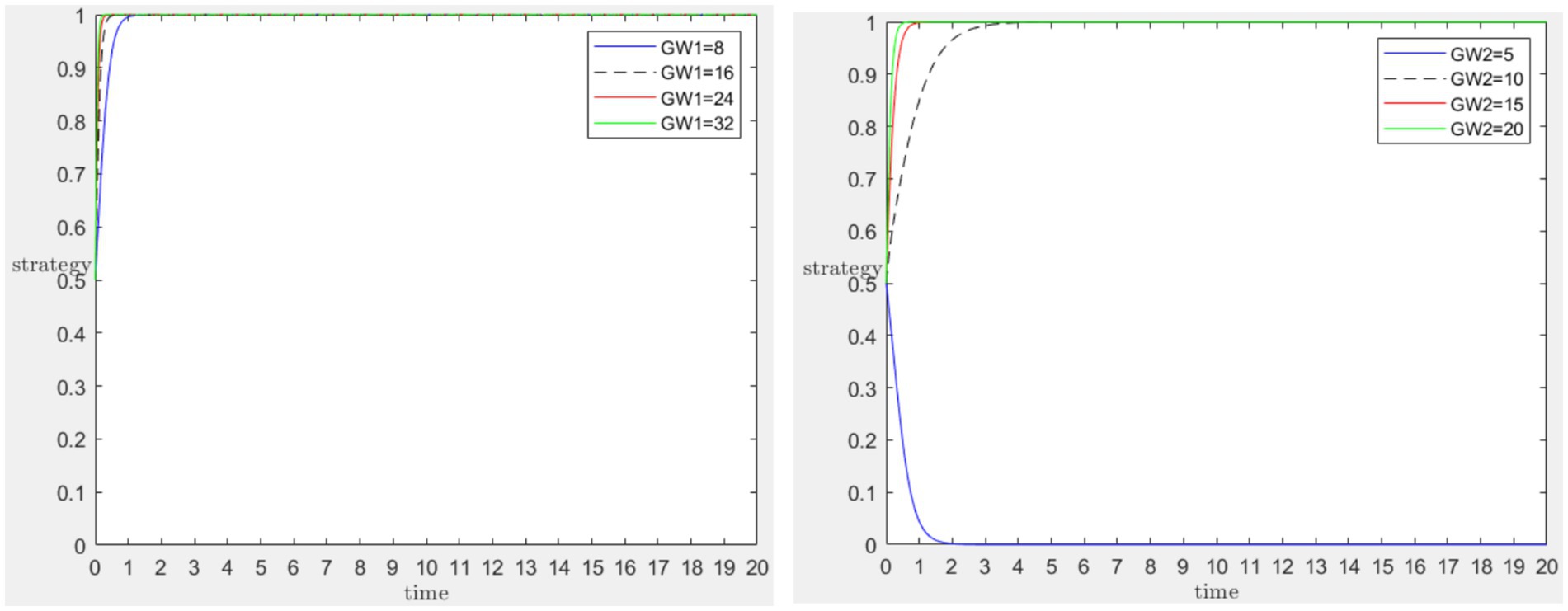
Figure 5. Evolutionary game simulation results of enterprises and university research institutes with increased government subsidy intensity and accuracy.
The FT1 and FT2 effects of farmers’ feedback on enterprises and university research institutes are set at values of 0.4, 0.8, 1.2, and 1.6, respectively. The simulation results show that farmers’ market demand feedback is positively correlated with the active participation of enterprises and university research institutes in agricultural green coordinated development strategies. As the effect of farmers’ behavior feedback on agricultural green scientific innovation and achievement transformation improves, the enthusiasm of enterprises, university research institutes to participate in agricultural green coordinated development significantly increases. This greater enthusiasm facilitates more timely follow-up on market demand research, as well as the development and transformation of effective market demand for agricultural green technology innovation products, as illustrated in Figure 6.
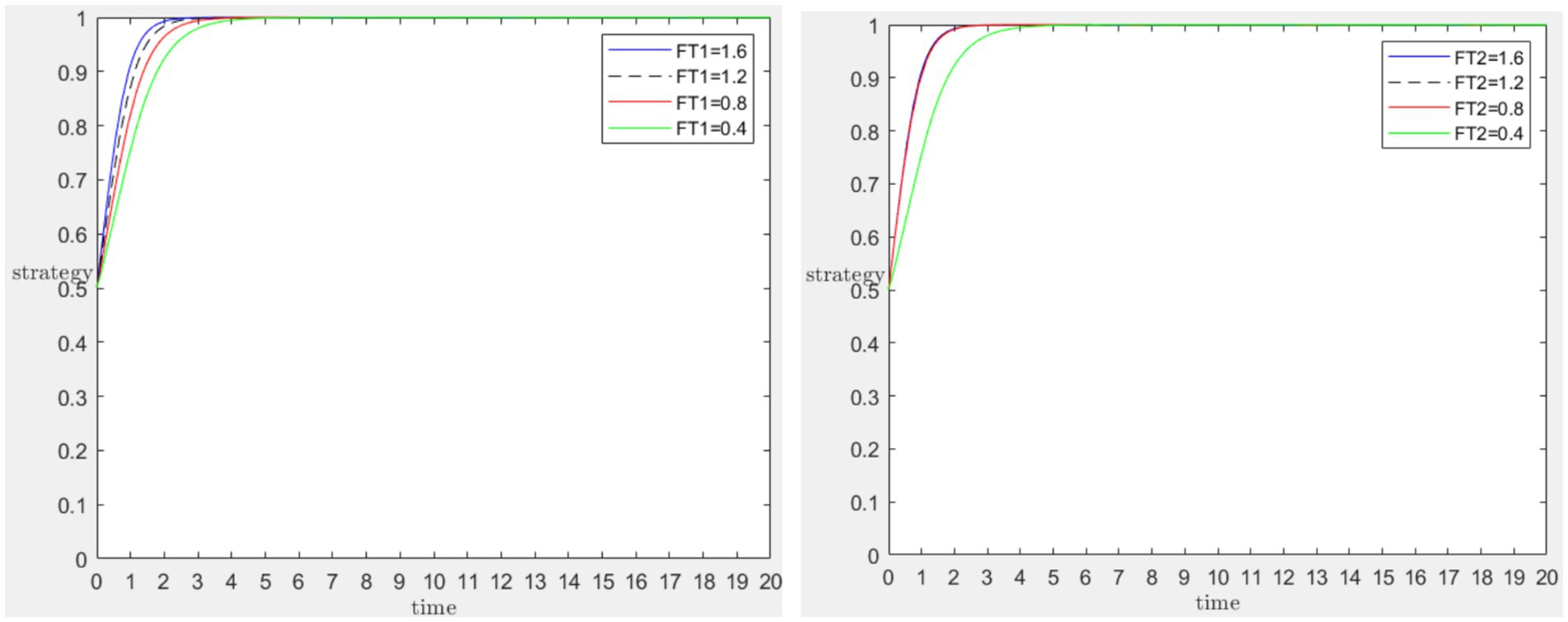
Figure 6. Evolutionary game simulation results of farmers’ demand feedback between enterprises and university research institutes.
Intellectual property protection intensity P is set at 2, 4, 6, and 8, respectively. The simulation results indicate that the intensity of intellectual property protection has a positive correlation with the active participation of enterprises and scientific research institutes in the strategy of agricultural green coordinated development. With the continuous improvement of the intensity of protection, the more effectively knowledge-free-riding behavior can be avoided, the more enthusiasm of enterprises, university research institutes to participate in the green collaborative development of agriculture is significantly increased, and the more urgent demand for intellectual property protection by universities and university research institutes. Refer to Figure 7 for details.
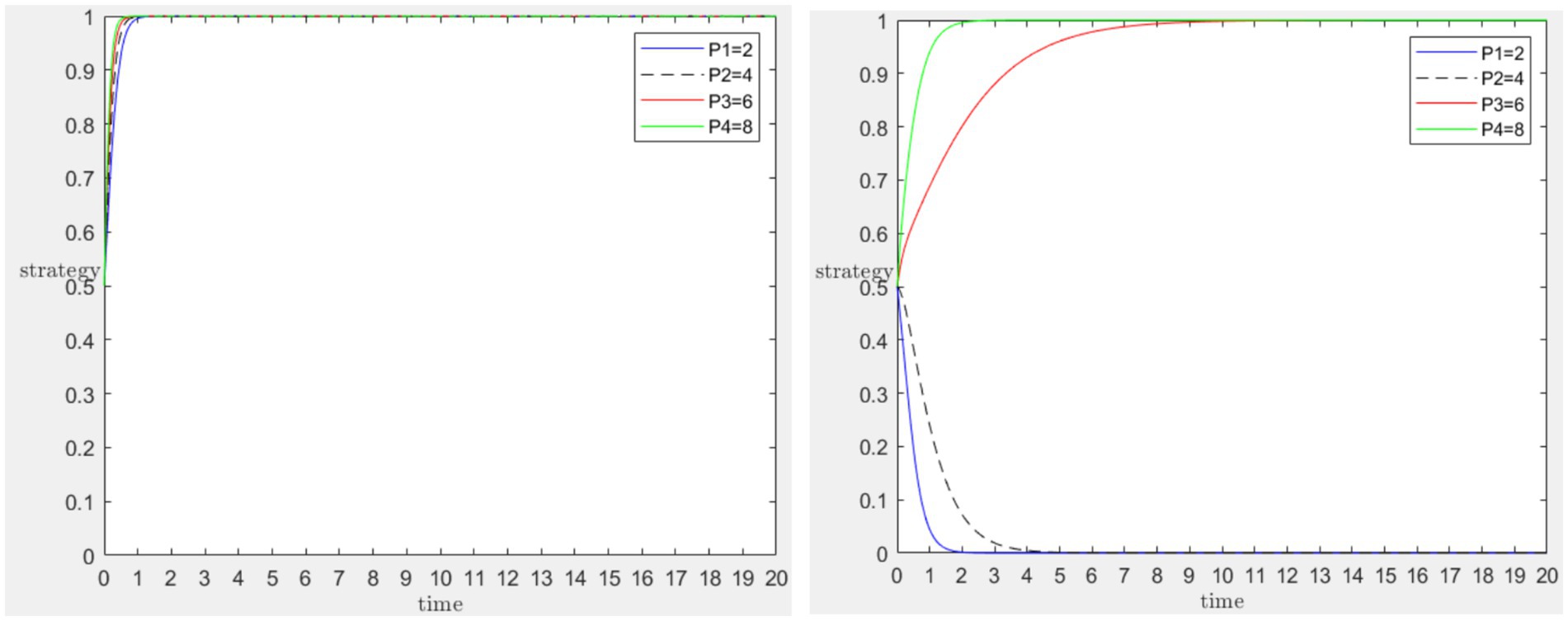
Figure 7. Evolutionary game simulation results of intellectual property protection between enterprises and university research institutes.
The spillover effects of agricultural green science and technology innovation, represented by i1 and i2, are set at values of 0, 1, 2, and 3, respectively. The simulation results indicate that the spillover effect of agricultural green science and technology innovation is negatively correlated with the active participation of enterprises and university research institutes in the agricultural green coordinated development strategy. As the spillover effect of agricultural green science and technology innovation increases, the phenomenon of free-riding becomes a rational economic behavior. This leads to a significant decrease in the enthusiasm of enterprises, university research institutes to engage in the agricultural green coordinated development strategy. Consequently, the game evolution rapidly converges toward a negative strategy, as shown in Figure 8.
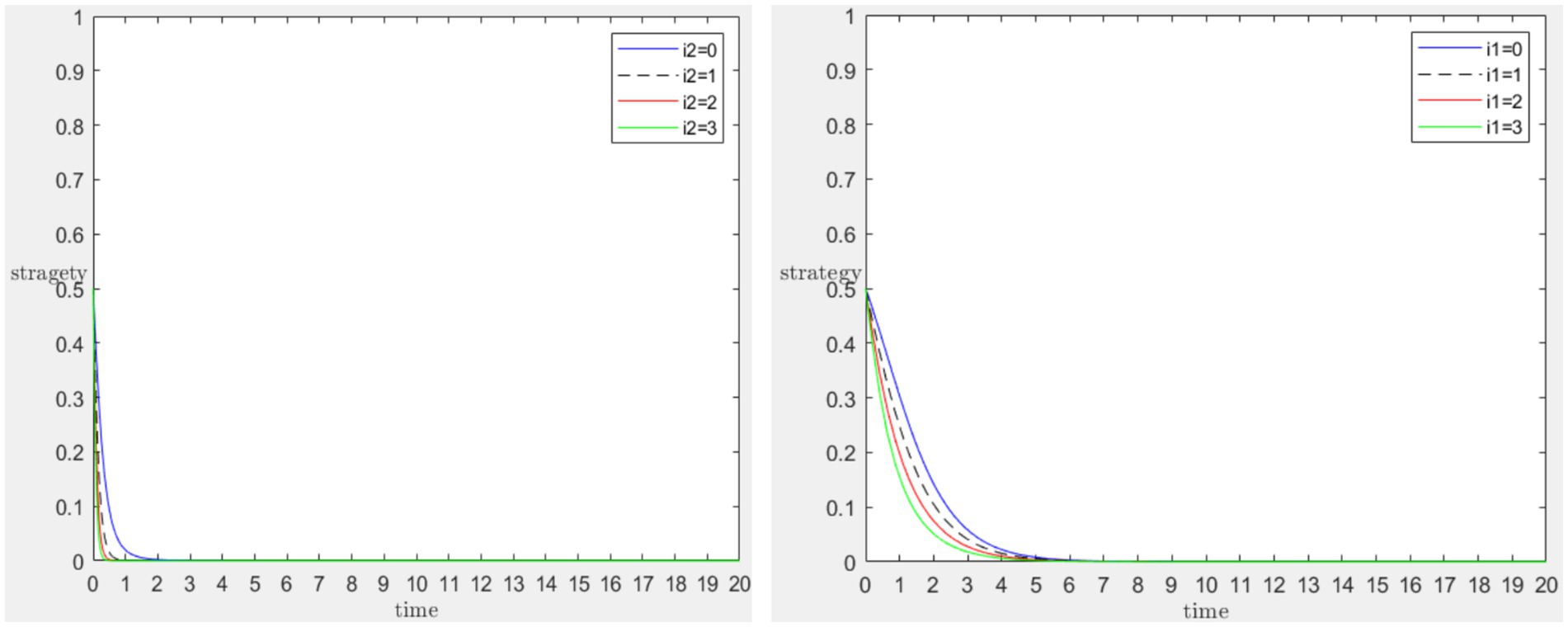
Figure 8. Evolutionary game simulation results of the spillover effect of agricultural green science and technology innovation between enterprises and university research institutes.
The coordination of agricultural green science and innovation, represented by D1-a and D2-b, are set to values of 1, 2, 3, and 4, respectively. The simulation results show that the synergistic effect of agricultural green science and innovation is positively correlated with the active participation of enterprises and university research institutes in the agricultural green collaborative development strategy. As the synergistic effect of agricultural green science and technology innovation continues to improve, the enthusiasm of enterprises, university research institutes to engage in the agricultural green coordinated development strategy increases significantly. This heightened enthusiasm leads to a rapid convergence of the game evolution toward the positive strategy, as illustrated in Figure 9.
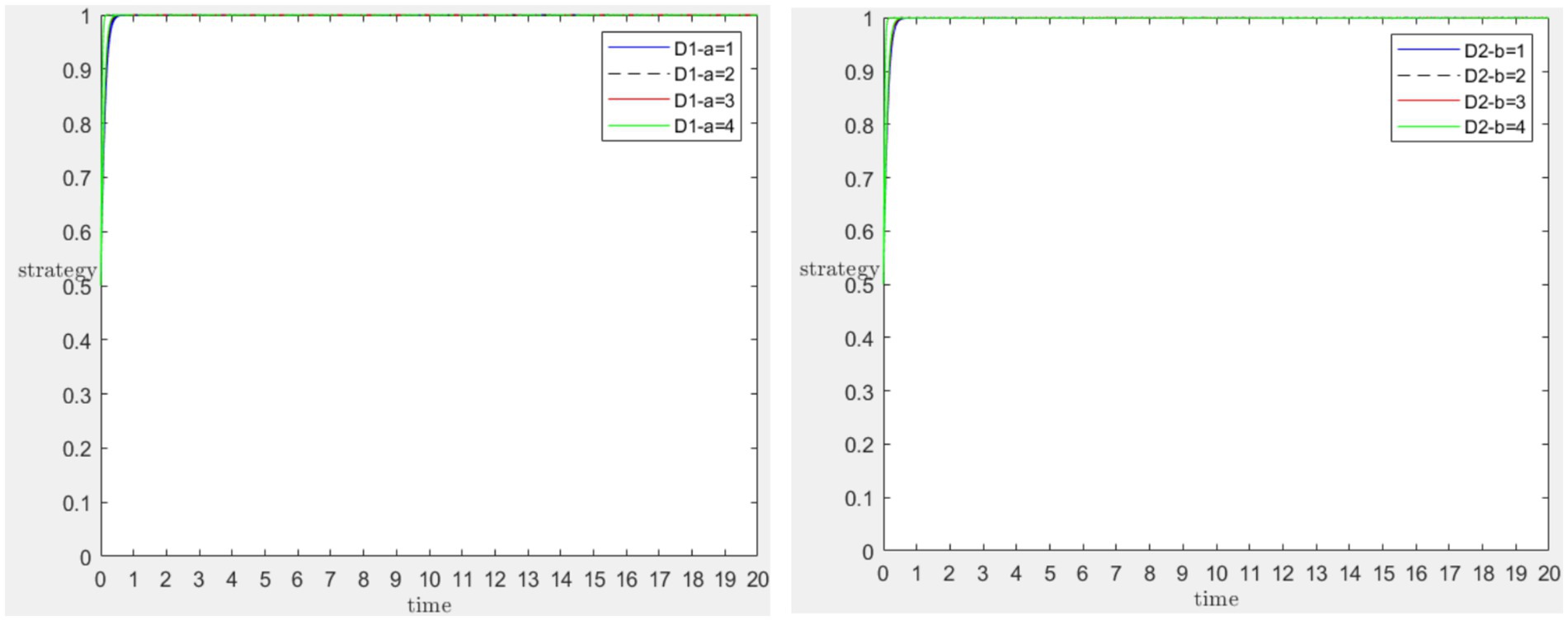
Figure 9. Evolutionary game simulation results of the synergistic effects of agricultural green science and innovation between enterprises and university research institutes.
To analyze the factors influencing the equilibrium of internal innovation-driven enterprises, university research institutes, and the evolution of the social capital game, this study selected the return on capital investment (R2) and the intensity of regulatory punishment and rights protection during coordination. A comparative analysis was conducted with the assumption that other parameters remained constant.
The initial R2 values were set at 0.5, 0.6, 0.7, and 0.8, respectively. The simulation results indicate that, during coordination, the return on investment for the capital side is positively correlated with the active participation of enterprises, university research institutes, and social capital side in the agricultural green collaborative development strategy. As the return on coordination investment increases, the enthusiasm of both sides for actively engaging in the strategy of agricultural green coordinated development rises significantly. This increase in enthusiasm is more conducive to the evolution of both sides in the agricultural green innovation strategy (Figure 10).
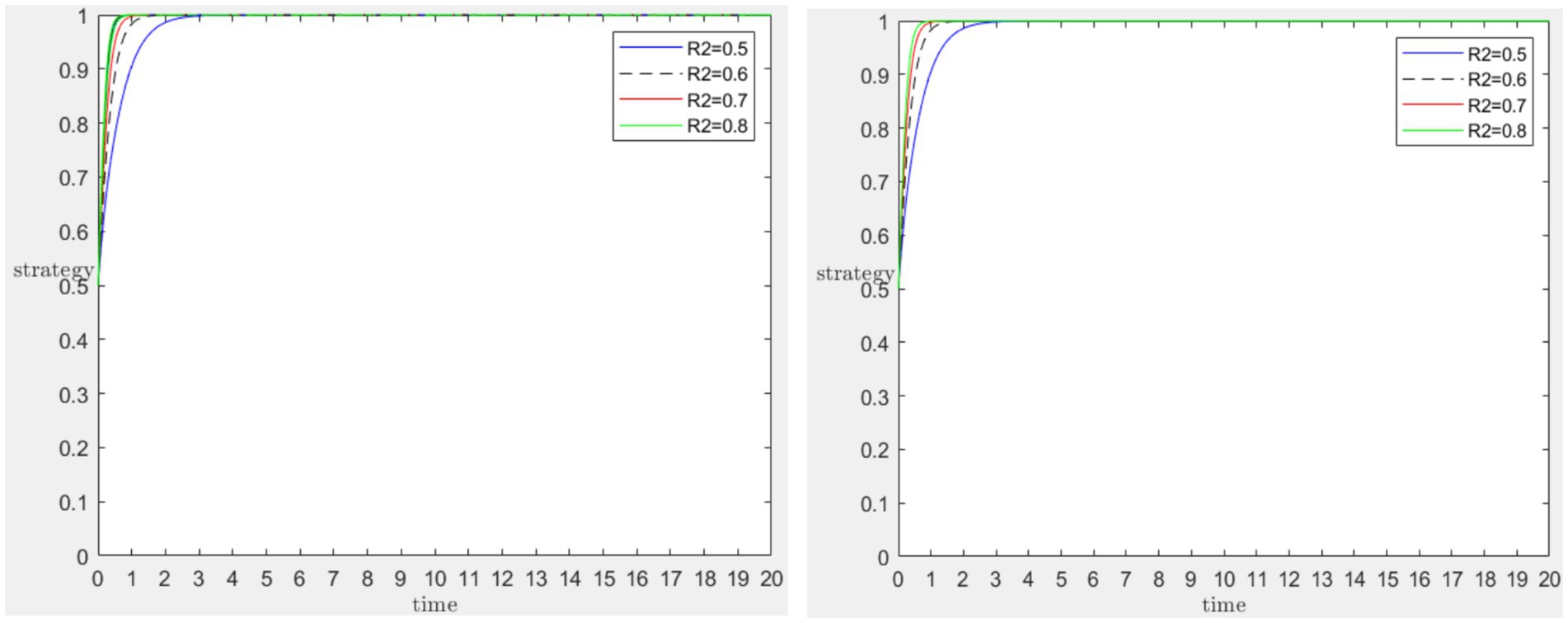
Figure 10. Game simulation results of capital investment return rate of enterprises, universities research institutes and social capital evolution during cooperation.
The initial value P is set at 5, 7, 9, and 11, respectively. The simulation results show that the intensity of regulatory punishment and rights protection has a positive correlation with the active participation of both social capital and enterprises, universities research institutes in the agricultural green coordinated innovation strategy. With the improvement of the intensity of regulatory punishment and rights protection, the enthusiasm of both parties to actively participate in agricultural green coordinated innovation has significantly increased, which is more conducive to the evolution of both parties to the agricultural green innovation strategy (Figure 11).
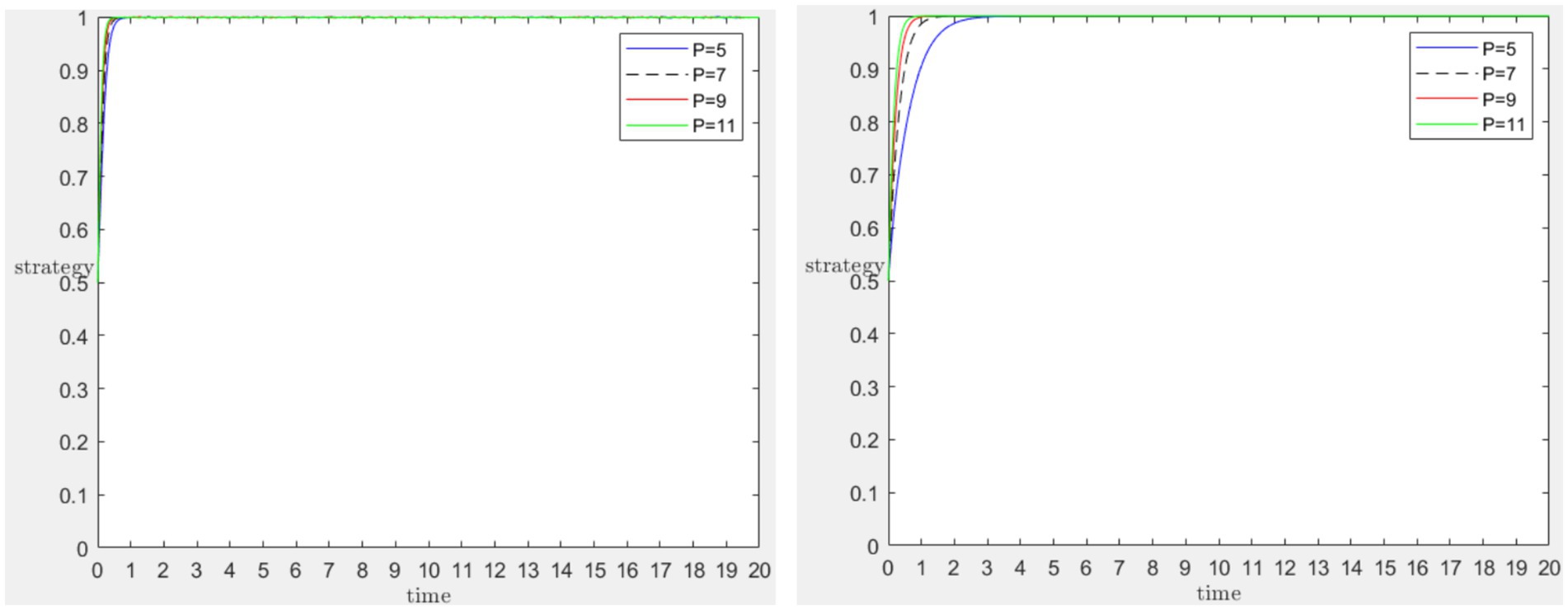
Figure 11. Game simulation results between enterprises, universities research institutes and social capital evolution with the intensity of supervision, punishment and rights protection.
4 Discussion
It has been widely acknowledged that strengthening government subsidies to farmers is conducive to the green development of agriculture (Zuoxiang and Jing, 2021; Xuan and Wei, 2021). In traditional research, policies are often considered background factors or general supportive concepts. This study considers the precision and intensity of subsidies as core variables, for the first time, confirms that the higher precision and intensity, more effectively stimulate the enthusiasm of enterprises and universities research institutes for coordinated participation. Meanwhile, the market demand-oriented game feedback design for agricultural scientific and technological innovation not only addresses the previous neglect of the market research component (Jean Jacques and Alexandra, 2012), but also establishes a closed-loop mechanism of demand identification, innovation response, technology transfer, reverse expansion and optimization. Regarding the issue of positive externalities in agricultural scientific and technological innovation, while some studies suggest that intellectual property protection hinders the open innovation process (Michele et al., 2021), this article discusses the necessity of intellectual property protection from the perspective of the coordination and spillover effects of agricultural scientific and technological innovation. The following conclusions are drawn:
i. Strengthen the government’s role in benefit distribution to farmers, and meanwhile enhance the precision and intensity of subsidy policies for enterprises and university research institutes.
ii. Align with market demand as a guiding principle, while improving feedback mechanisms from multiple sources.
iii. Enhance intellectual property protection to foster innovation, collaboration, and return on investment, while minimizing cooperation barriers due to knowledge gaps.
iv. Mitigate the spillover effects of agricultural green technology innovation to ensure positive interaction between technological advancements and system stability.
This study innovatively integrates evolutionary game theory and system dynamics for application in the field of green and coordinated agricultural development, overcoming the limitations of traditional static analysis and localized coordinated perspectives. For the first time, a six-agent evolution model was constructed, quantifying the collaborative mechanism between innovation and policy. The findings in the research have provided direction for the government to optimize agricultural green coordinated development. The following suggestions are proposed:
i. Formulate a Tiered Subsidy Policy: The government should create a comprehensive database on farmers’ green production, including details such as land size, crop types, and cost-effectiveness. By utilizing big data analysis, the government can target subsidies more accurately, ensuring appropriate quotas and distributions. Additionally, the government should establish a dynamic database of demands for agricultural green development, precisely matching the technological research and development, as well as service directions of universities research institutions, and implement stepwise subsidies based on the effectiveness of technology transfer.
ii. Build a Six-in-One Information Sharing Platform: Establish a dedicated market research team that utilizes big data and AI technologies to collect and analyze agricultural market demand, including product categories, quantities, and quality preferences. The platform should regularly update and publish this data, organizing exchange activities to encourage feedback from farmers, enterprises, and other stakeholders. The information will help optimize agricultural green production and service strategies based on real-time needs and issues.
iii. Improve Supervision Mechanisms for Collaborative Innovation Entities: A multi-party regulatory mechanism should be established, involving government bodies, enterprise associations, and consumers to create a robust oversight framework. Technologies like blockchain can be used to monitor coordinated innovation trends in real time, improving the speed of regulatory responses and enhancing information transparency. Additionally, a credit system should be implemented, linking credit evaluation results of coordinated entities to market access, creating both positive incentives and negative consequences.
iv. Establish a Revenue-Sharing Mechanism for Agricultural Green Innovation: The government should strengthen the intellectual property legal system by simplifying the patent application process, reducing costs associated with rights protection, and encouraging innovation. A special fund should be created to provide financial support for green agricultural innovation projects, facilitating technology transfer and coordination between universities research institutions and enterprises. This will help balance the interests of all parties, bridge knowledge gaps, and promote coordinated innovation.
5 Limitation
Although this study has contributed to understanding the mechanisms of agricultural green coordinated development, several limitations remain. Firstly, it is challenging to account for all real-world factors in the model, such as sudden natural disasters or significant fluctuations in the international agricultural products market. These factors may cause some deviation between the research findings and actual conditions.
Secondly, due to the difficulty in obtaining realistic data, the empirical analysis is somewhat limited. The parameter settings in the model may not fully capture the complexities and dynamic nature of the real-world situation, meaning that the explanatory power and generalizability of the research conclusions require further validation and refinement.
Thirdly, the study does not fully consider the regional variations in agricultural green coordinated development, such as differences in economic levels, resource endowments, and the intensity of policy implementation. This oversight results in a lack of regional relevance in the constructed mechanism, which diminishes the applicability of the research findings across diverse regional contexts.
6 Outlook
First, the model construction should be optimized by incorporating additional realistic variables. This includes developing a dynamic model that accounts for the impact of natural disasters and fluctuations in international markets. By doing so, the theoretical mechanism can better align with real-world conditions, thereby enhancing the practical relevance and guiding value of the research.
Second, data collection channels should be expanded. Utilizing big data technology and cross-regional cooperation can provide a richer dataset. Optimizing parameter settings and strengthening empirical research will improve the accuracy and reliability of the conclusions. This will enhance the generalizability and persuasiveness of the results, further bridging the gap between agricultural green coordinated development theory and its practical implementation.
Third, a regional differentiation analysis should be conducted, gathering region-specific data based on unique local characteristics. This will enable the development of a regionally adaptive agricultural green coordinated collaborative development model. By strengthening comparative research across regions and exploring cross-regional coordination mechanisms, the research findings can better guide agricultural green development practices in diverse regional contexts.
Data availability statement
The raw data supporting the conclusions of this article will be made available by the authors, without undue reservation.
Author contributions
YY: Conceptualization, Formal analysis, Investigation, Methodology, Writing – original draft, Writing – review & editing. MU: Data curation, Writing – review & editing. XY: Validation, Visualization, Writing – review & editing. MQ: Data curation, Writing – review & editing.
Funding
The author(s) declare that financial support was received for the research and/or publication of this article. This work was supported by the Ministry of Science and Technology of the People’s Republic of China National Foreign Experts Project “Carbon Reduction Path and Development Strategy Selection of the Construction Industry under the Dual Carbon Target” under grant number “G2022172011L” and the Major Theoretical and Practical Issues Research Project of Philosophy and Social Sciences of Shaanxi Province “Research on Multi-agent Collaborative Mechanism and Realization Path in Green Agricultural Development in Qinba Mountain Area” under grant number “2022ND0338.”
Acknowledgments
We would like to express our sincere gratitude to Professor Q for her invaluable guidance and support throughout the research process. We are also grateful to G2022172011L and 2022ND0338 for their financial support, which made this research possible.
Conflict of interest
The authors declare that the research was conducted in the absence of any commercial or financial relationships that could be construed as a potential conflict of interest.
Generative AI statement
The authors declare that no Gen AI was used in the creation of this manuscript.
Publisher’s note
All claims expressed in this article are solely those of the authors and do not necessarily represent those of their affiliated organizations, or those of the publisher, the editors and the reviewers. Any product that may be evaluated in this article, or claim that may be made by its manufacturer, is not guaranteed or endorsed by the publisher.
References
Ansell, C., and Gash, A. (2008). Collaborative governance in theory and practice. J. Public Adm. Res. Theory 18, 543–571. doi: 10.1093/jopart/mum032
Belanchee, A., Martin-Collado, D., Rose, G., and Yáñez-Ruiz, D. R. (2021). A multi-stakeholder participatory study identifies the priorities for the sustainability of the small ruminants farming sector in Europe. Animal 2:100131. doi: 10.1016/J.ANIMAL.2020.100131
Bryson, J. M., Crosby, B. C., and Stone, M. M. (2006). The design and implementation of cross-sector collaborations: propositions from the literature. Public Adm. Rev. 66, 44–55. doi: 10.1111/j.1540-6210.2006.00665x
Chenjun, G., Mingquan, W., and Shaohong, Z. (2020). Thoughts on improving rate of agricultural scientific and technological achievements in Fujian under the background of rural revitalization strategy. Taiwan Agric. Res., 76–81. doi: 10.16006/j.cnki.twnt.2020.03.013
Christoph, G. (2019). Applications of learning curves in production and operations management: a systematic literature review. Comput. Ind. Eng. 131, 422–441. doi: 10.1016/j.cie.2018.10.030
Conway, G. R., and Barbier, E. B. (2013). After the green revolution: sustainable agriculture for development. London: Routledge.
Fuhua, Y., Meiqiu, C., Qinglong, H., Zixu, Y., Yiren, L., and Fulin, Z. (2025). Social networks and farmers' low-carbon rice farming intention and behavioral discrepancies under the social embedding perspective. J. Clean. Prod. 491:144814. doi: 10.1016/j.jclepro.2025.144814
Genming, Z., and Manning, Z. (2020). The stability of industry-university-research innovation alliance based on evolutionary game. Oper. Res. Manage. Sci. 29, 67–73.
Haixia, C., Yixiang, Z., and Banghong, Z. (2018). Analysis on policy evolution and policy system of EU agricultural green development support: based on the policy evaluation of OECD. Issues Agric. Econ. 5, 130–142. doi: 10.13246/j.cnki.iae.2018.05.010
Hemmert, M., Bstieler, L., and Okamuro, H. (2014). Bridging the cultural divide: trust formation in university-industry research collaborations in the US, Japan and South Korea. Technovation 34, 605–616. doi: 10.1016/j.technovation.2014.04.006
Huafeng, D., Zhenzhong, G., and Jianbiao, R. (2023). Technological innovation pattern and pricing strategy choice for enterprise considering strategic consumers. J. Ind. Eng. Eng. Manag. 37, 183–200. doi: 10.13587/j.cnki.jieem.2023.06.016
Huijiao, X., Congzhi, H., and Jingzhong, Y. (2017). "De-small-scale agriculture" and "re-small-scale agriculture"? Rethinking food safety. Issues Agric. Econ. 8, 66–75. doi: 10.13246/j.cnki.iae.2017.08.009
Huogen, W., and Shuang, H. (2024). Study on synergistic effect of agricultural green development in Jiangxi Province. J. Saf. Environ. 5, 2043–2054. doi: 10.13637/j.issn.1009-6094.2023.1017
Jean Jacques, D., and Alexandra, E. (2012). Agriculture and development: a brief review of the literature. Econ. Syst. 36, 175–205. doi: 10.1016/j.ecosys.2011.09.003
Jekaterina, M., Andrew, F. F., Susanne, V. M., and Anna, M. H. (2023). Building agricultural innovation capacity from the bottom up: using spillover effects from projects to strengthen agricultural innovation systems. Agric. Syst. 209:103670. doi: 10.1016/j.agsy.2023.103670
Jian, H., Qinliang, T., Qingchao, J., Yihan, L., Yuan, L., and Yuwei, W. (2023). Simulating the CCUS technology diffusion in thermal power plants: an agent-based evolutionary game model in complex networks. J. Clean. Prod. 421. doi: 10.1016/j.jclepro.2023.138515
Jianfang, P. (2011). The quality and safety of agricultural products under the cooperative institutional change of supply chain. J. South China Agric. Univ. Soc. Sci. Ed. 2, 33–40.
Jianhui, Y., and Kaixuan, Z. (2024). Social capital, crop differences and adoption of alternative technologies for agrochemical inputs: based on the survey data of 942 farmers in Shandong Province. J Agrotech Econ. 6, 90–106. doi: 10.13246/j.cnki.jae.2024.06.004
Jielong, L. (1997). State-owned enterprise reform: the theory of multi-subject cooperative promotion – comments on the reform view of peasant households. Reform Econ. Syst. 1, 46–51.
Jing, Z. (2022). Spatial spillover effect of agricultural intellectual property protection on green technology innovation. J. Tech. Econ. Manag. 3, 34–39.
Jun, W., and Hao, W. (2024). Research on the network evolution characteristics and influencing factors of agricultural patent cooperation of countries along “the belt and road”. Sci. Manage. Res. 42, 157–170.
Khatri-Chhetri, A., Pant, A., Aggarwal, P. K., Vasireddy, V. V., and Yadav, A. (2019). Stakeholders prioritization of climate-smart agriculture interventions: evaluation of a framework. Agric. Syst. 174, 23–31. doi: 10.1016/j.agsy.2019.03.002
Langemeyer, J., Gómez-Baggethun, E., Haase, D., Scheuer, S., and Elmqvist, T. (2016). Bridging the gap between ecosystem service assessments and land-use planning through multi-criteria decision analysis (MCDA). Environ. Sci. Pol. 62, 45–56. doi: 10.1016/j.envsci.2016.02.013
Li, M., Siyi, X., and Hualou, L. (2025). Study on the influence and mechanism of agricultural green development pilot zone policy on the eco-efficiency of cultivated land use: a test based on multi-period difference-in-difference model. Resour Sci. 10:13:28.
Lingdi, Z., Zhibo, Z., and Shasha, L. (2020). Analysis of agricultural non-point source pollution control in Baiyangdian—based on evolutionary game model between government and farmers. J. Beijing Inst. Technol. (Soc. Sci. Ed.). 22, 48–56. doi: 10.15918/j.jbitss1009-3370.2020.1475
Michele, G., Marco, G., and Livio, C. (2021). A framework of intellectual property protection strategies and open innovation. J. Bus. Res. 123, 156–164. doi: 10.1016/j.jbusres.2020.09.043
Mingzhong, L., and Xiankai, L. (2022). Non-agricultural employment experience, risk preference and new farmers’ adoption of production technology. J. Jiangsu Univ. (Soc. Sci. Ed.). 24, 44–56. doi: 10.13317/j.cnki.jdskxb.2022.015
Qian, Z. (2023). Under the guidance of government policies, state-owned enterprises introduce evolutionary game and simulation analysis of strategic investors. Oper. Res. Manage. Sci. 6, 97–103.
Qiannan, L., Gucheng, L., and Chaojing, Y. (2022). Regional differences and convergence of agricultural green development level in China: an empirical study based on panel data of prefecture-level cities. J. China Agric. Univ. 2, 230–242.
Qilong, H., Juanhong, T., Xing, L., and Xianjia, W. (2023). Evolutionary game analysis of agricultural non point source pollution coordinated governance by government, agricultural enterprise and farmers. Chin. J. Manage. Sci. 31, 202–213. doi: 10.16381/j.cnki.issn1003-207x.2022.1319
Qun, G., Hengyang, C., and Xinliang, Z. (2023). Evolution and focal features of China’s agricultural green development policies: text analysis based on attention perspective. Resour Sci 45, 2433–2448. doi: 10.18402/resci.2023.12.10
Rodriguez-Campos, L. (2012). Advances in collaborative evaluation. Eval. Program Plann. 35, 523–528. doi: 10.1016/j.evalprogplan.2011.12.006
Selin, S., and Cheez, D. (1995). Developing a collaborative model for environmental planning and management. Environ. Manag. 2, 189–195. doi: 10.1007/BF02471990
Shuangqing, T., Hai, J., and Lei, C. (2021). The action logic and system balance between farmers right and interests and governments public interests. J. Southwest Univ. (Soc. Sci. Ed.). 47, 81–90. doi: 10.13718/j.cnki.xdsk.2021.02.008
Talukder, B., Blay-Palmer, A., Hipel, K. W., and Gary, W. V. (2017). Elimination method of multi-criteria decision analysis (MCDA): a simple methodological approach for assessing agricultural sustainability. Sustainability. 2:287. doi: 10.1007/s00500-023-09011-0
Wei, J., Dihai, W., and Lin, Z. (2022). Low-carbon transition of the Chinese economy in the context of carbon neutrality: an analysis of characteristic facts and mechanisms. Econ. Res. J. 12, 87–103.
Weihong, W., Zhangming, D., and Aimei, Z. (2018). An evolutionary game analysis of multi-agent collaborative innovation based on two-wheel drive. Commer. Res. 8, 133–143. doi: 10.13902/j.cnki.syyj.2018.08.016
Wijaja, A., Glasbergen, P., Leroy, P., and Darmastuti, A. (2018). Governance challenges of cocoa partnership projects in Indonesia: seeking synergy in multi-stakeholder arrangements for sustainable agriculture. Environ. Dev. Sustain. 1, 129–153.
Xiao, C., Jingyu, F., Chao, G., and Canlei, L. (2025). Industry-research compatibility and innovation spillovers from public research. J. Quant. Technol. Econ. 42, 135–156.
Xiaoxiao, Z., Mengyu, J., and Xin, Z. (2023). An empirical study and evolutionary game analysis of green finance promoting Enterprise green technology innovation. China Ind. Econ. 6, 43–61. doi: 10.19581/j.cnki.ciejournal.2023.06.002
Xiaozhou, H., Wan, T., and Yong, P. (2016). Evolutionary game analysis of respective stakeholders during promotion process of low – carbon agriculture. J. Northwest A & F Univ. (Soc. Sci. Ed). 16, 59–65. doi: 10.13968/j.cnki.1009-9107.2016.01.10
Xingbin, L., Feng, S., and Peng, L. (2014). Research on dynamic game and coordination mechanism construction of the main body of transformation and popularization of agricultural scientific and technological achievements. Sci. Technol. Progress Policy 31, 24–27. doi: 10.6049/kjjbydc.2013050719
Xiuchuan, X., and Pengyan, W. (2022). The evolution of the development mechanism of green agriculture -- based on the perspective of tripartite game among government, farmers and consumers. J. China Agric. Univ. 1, 259–273.
Xiuchuan, X., and Yande, W. (2024). Farmers' risk avoidance, herd effect and transformation of agricultural green production—evolutionary game analysis based on the model of “enterprises + cooperatives + farmers”. J. Southwest Univ. (Nat. Sci. Ed.). 46, 103–115. doi: 10.13718/j.cnki.xdzk.2024.03.009
Xuan, X., and Wei, S. (2021). Study on the evaluation of agricultural green development from the perspective of rural revitalization. Study Explor. 3, 130–136.
Xufang, L., and Yangmei, Z. (2024). Research on the evolutionary game of green agricultural production through the collaboration of government, enterprises and farmers. Agric. Technol. 44, 128–134. doi: 10.19754/j.nyyjs.20241215028
Yafei, W., and Shuang, T. (2013). Game analysis and improvement of leading enterprises and farmers in the process of agricultural industrialization in China – on the institutional characteristics of different organizational models. Issues Agric. Econ. 11, 50–57. doi: 10.13246/j.cnki.iae.2013.11.014
Yanli, Y., and Hua, L. (2021). Green production performance of tea farmers under multi-subject collaborative governance. Resourc. Environ. Yangtze Basin 9, 2299–2310.
Yao, S., Zerui, M., Yawen, L., Zilai, S., and Junhu, R. (2025). Influence of agricultural subsidy policy on green production based on meta-analysis. J. Syst. Manag. 34, 137–151. doi: 10.3969/j.issn2097-4558.2025.01.011
Yijie, W., Wanqing, L., and Yi, Z. (2024). Evolution of free riding behavior in low-carbon innovation network considering herd effect: stochastic game analysis based on Moran process. J. Huaqiao Unive. (Philos. Soc. Sci.)., 76–92. doi: 10.16067/j.cnki.35-1049/c.2024.01.011
Yingying, M., Qin, W., Wenyan, Y., and Huidong, Z. (2023). Evolution mechanism and improvement path of collaborative governance of pollution reduction and carbon reduction by government and enterprises under the goal of "dual carbon". J. China Univ. Pet. (Ed. Soc. Sci). 6, 23–31. doi: 10.13216/j.cnki.upcjess.2023.06.0004
Yongabo, P., and Goktepe-Hultén, D. (2021). Emergence of an agriculture innovation system in Rwanda: stakeholders and policies as points of departure. Ind. High. Educ. 35, 581–597. doi: 10.1177/0950422221998610
Yuehua, Z., and Ye, Z. (2022). Research on the adoption of green technologies in agricultural enterprises based on evolutionary game theory. Agric. Technol. 42, 144–147. doi: 10.19754/j.nyyjs.20220630036
Yuhan, B., Kai, F., Kuan, Z., Xiaochun, C., Hui, L., and Yintang, Y. (2021). Blockchain-based trust management for agricultural green supply: a game theoretic approach. J. Clean. Prod. 310, 1–10. doi: 10.1016/j.jclepro.2021.127407
Zhe, C., and Bin, G. (2023). Research on dynamic evolution game mechanism of university-industry research deep integration: based on the perspective of innovation process. J. Technol. Econ. 42, 24–40.
Zhe, B., Xiaoliang, Z., and Kairong, L. (2024). Evolutionary game analysis of agricultural non⁃point source pollution control behavior. Oper. Res. Manage. Sci. 33, 57–63. doi: 10.12005/orms.2024.0009
Zhiying, Z., Bing, L., and Qihui, L. (2024). Joint investment strategy of new R & D institutions and social capital under the background of scientific and technological self-reliance: theoretical analysis based on dynamic game model. Sci. Technol. Manage. Res. 44, 144–156. doi: 10.3969/j.issn.1000-7695.2024.15.016
Zhiyuan, T., and Weihong, H. (2022). Research on the impact of government fiscal subsidies on enterprise innovation efficiency based on the super-efficiency DEA-tobit model. Manag. Adm. 7, 60–67. doi: 10.16517/j.cnki.cn12-1034/f.2022.07.009
Zhou, L. (2023). Green agricultural development in China: innovation and evolution. Chin. Rural Econ. 2, 2–16. doi: 10.20077/j.cnki.11-1262/f.2023.02.001
Zuhui, H. (2018). Accurately grasp China's rural revitalization strategy. Chin. Rural Econ. 4, 2–12.
Keywords: agricultural green development, innovation-policy coordination, game evolution, mechanism exploration, balanced and stable simulation
Citation: Yuan Y, Umer M, Yang X and Qu M (2025) Agri-sustainability transitions: innovation-policy coordination mechanisms in green system restructuring. Front. Sustain. Food Syst. 9:1628073. doi: 10.3389/fsufs.2025.1628073
Edited by:
Zhenshuang Wang, Dongbei University of Finance and Economics, ChinaReviewed by:
Jingkuang Liu, Guangzhou University, ChinaMingyang Han, Minzu University of China, China
Copyright © 2025 Yuan, Umer, Yang and Qu. This is an open-access article distributed under the terms of the Creative Commons Attribution License (CC BY). The use, distribution or reproduction in other forums is permitted, provided the original author(s) and the copyright owner(s) are credited and that the original publication in this journal is cited, in accordance with accepted academic practice. No use, distribution or reproduction is permitted which does not comply with these terms.
*Correspondence: Mei Qu, bWVpLnF1QG53c3VhZi5lZHUuY24=
 Yunxiao Yuan
Yunxiao Yuan Muhammad Umer
Muhammad Umer Xiaoyu Yang
Xiaoyu Yang Mei Qu
Mei Qu


